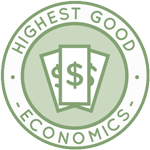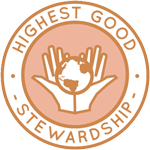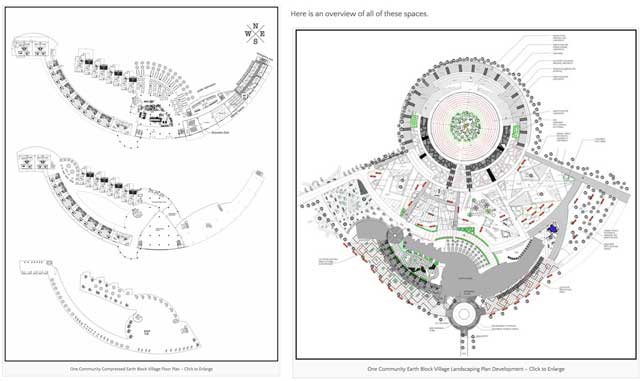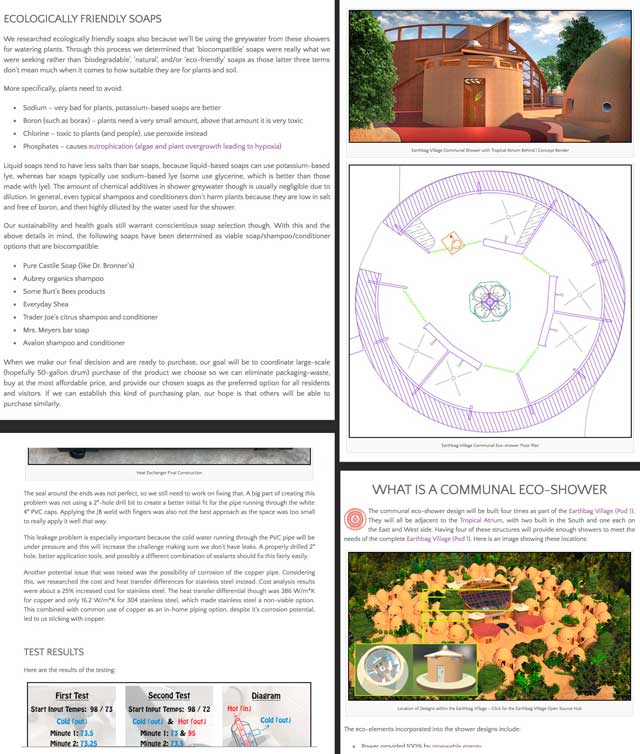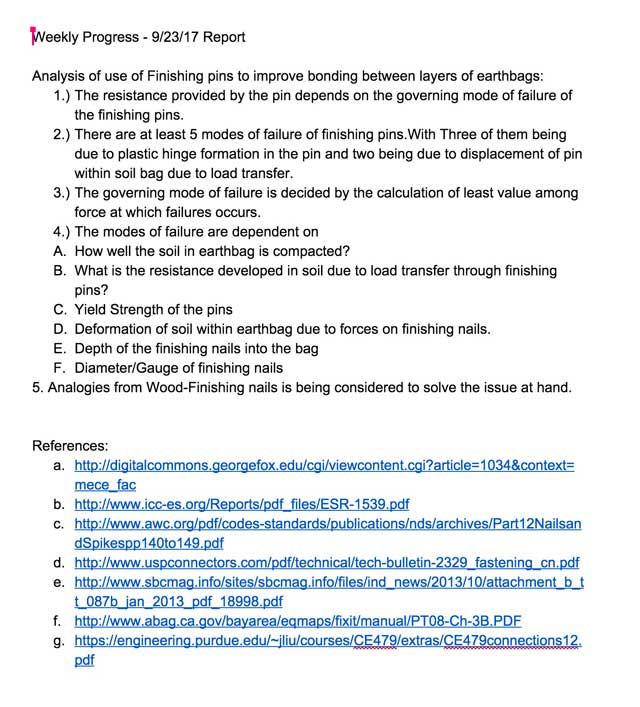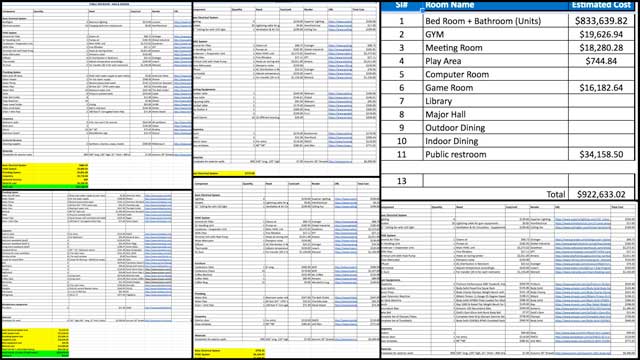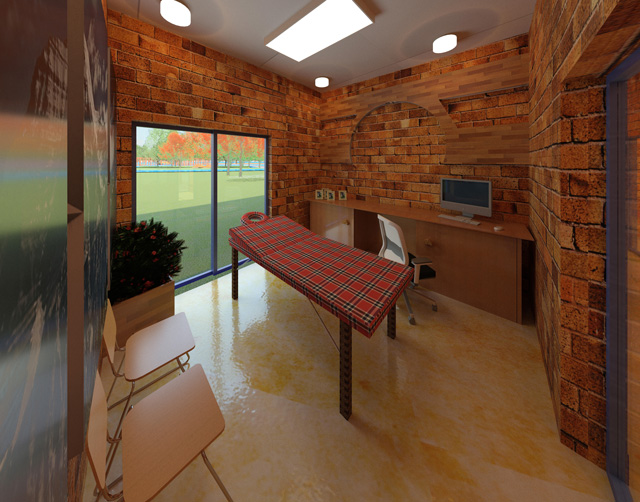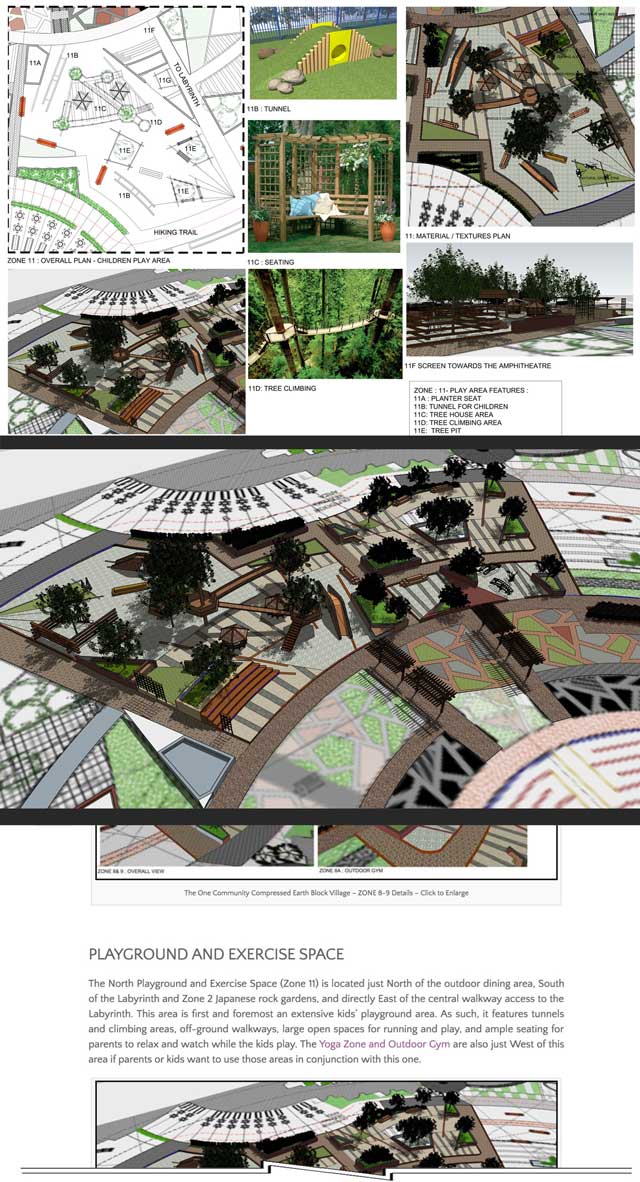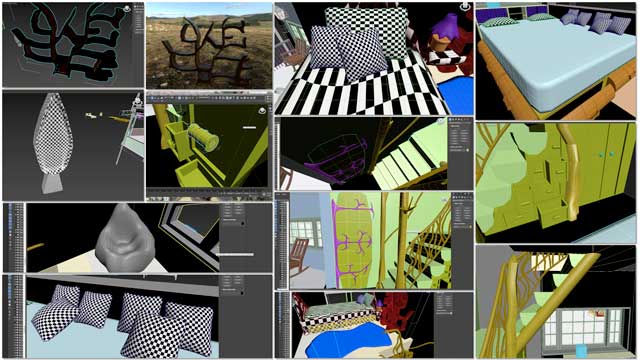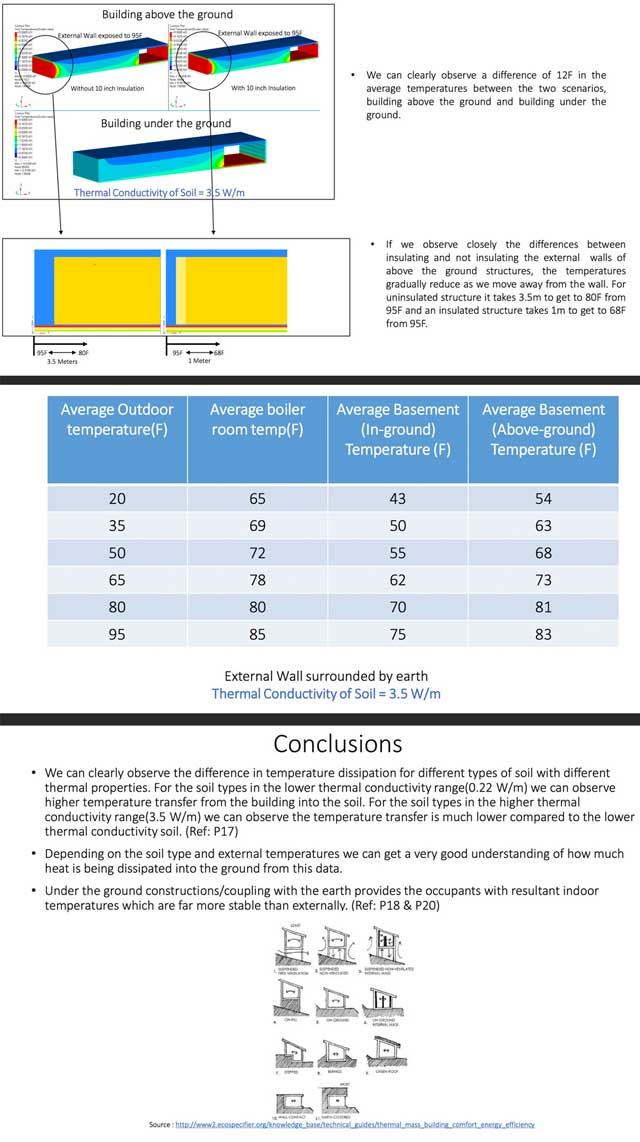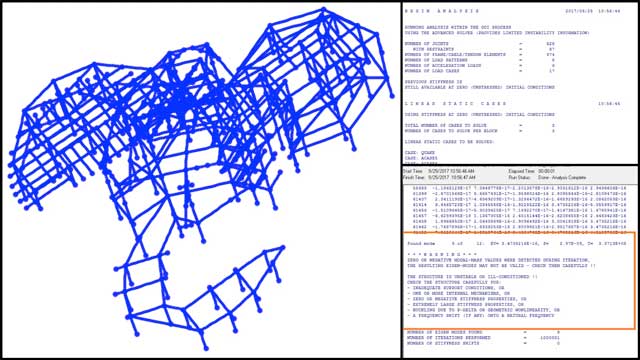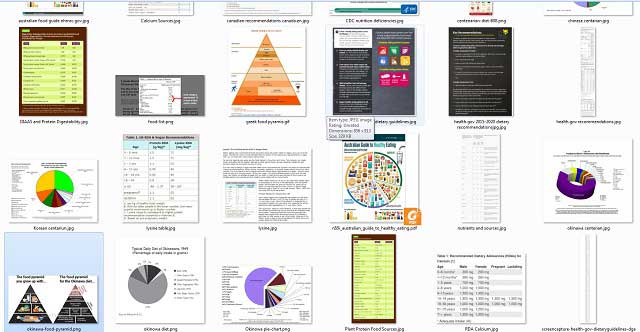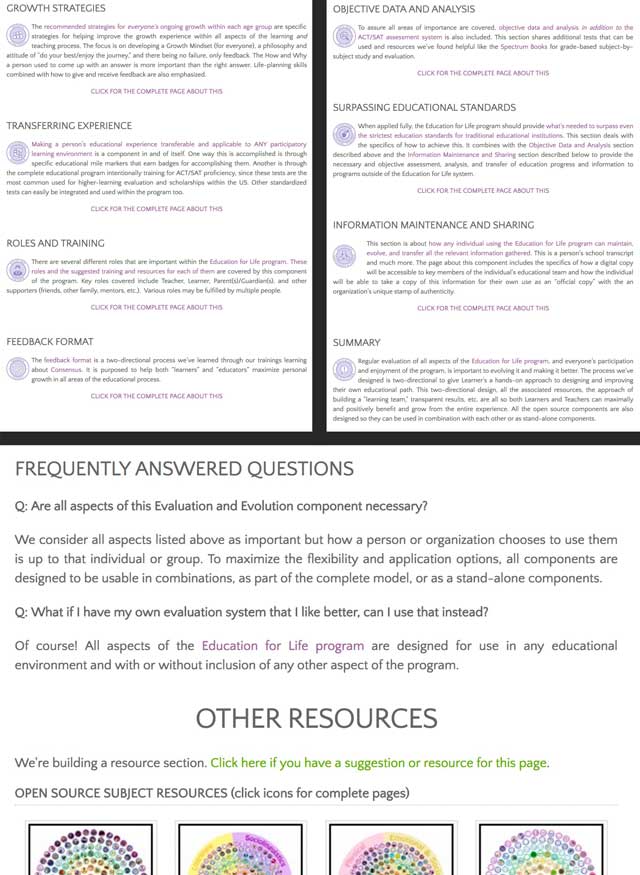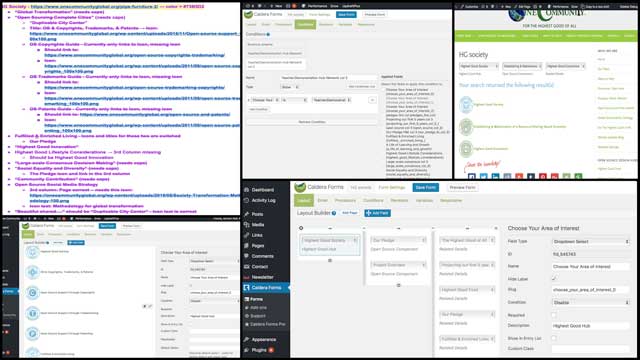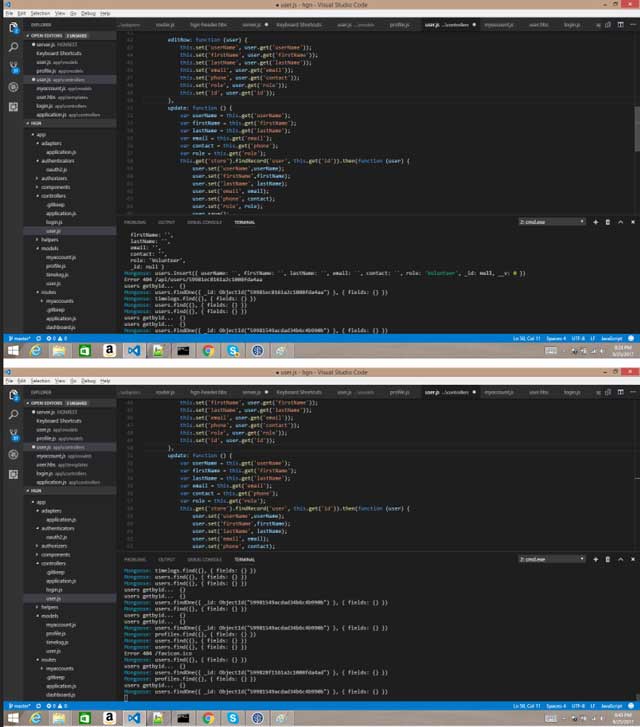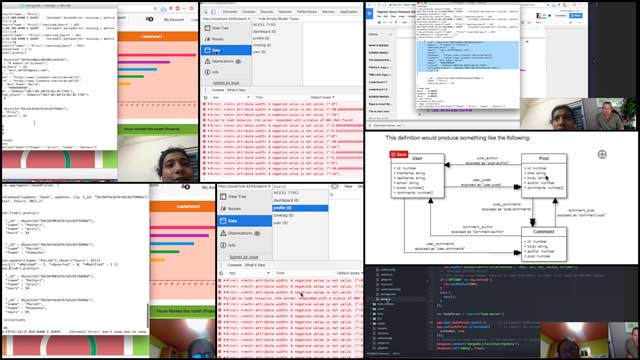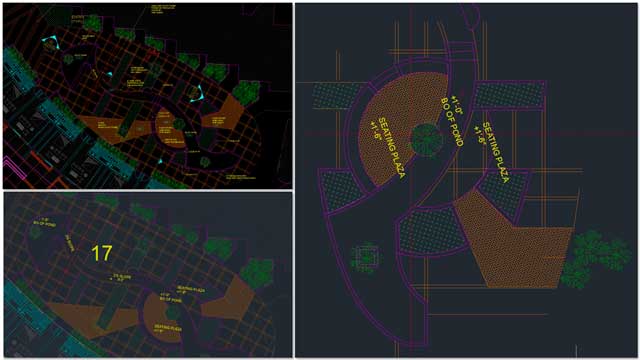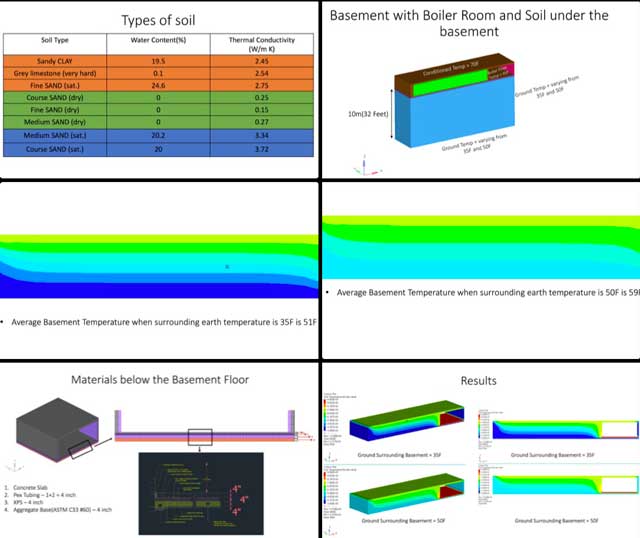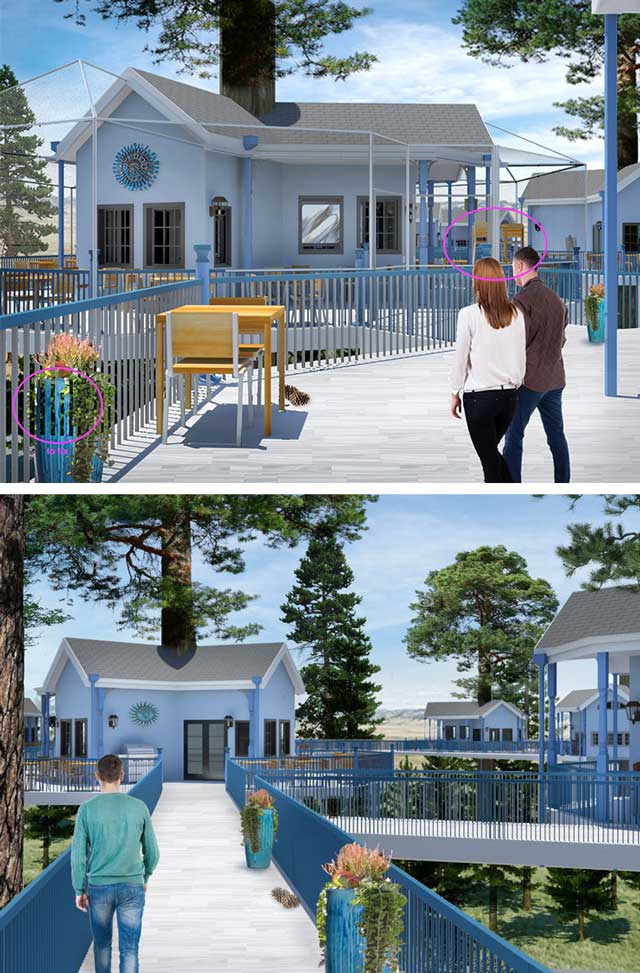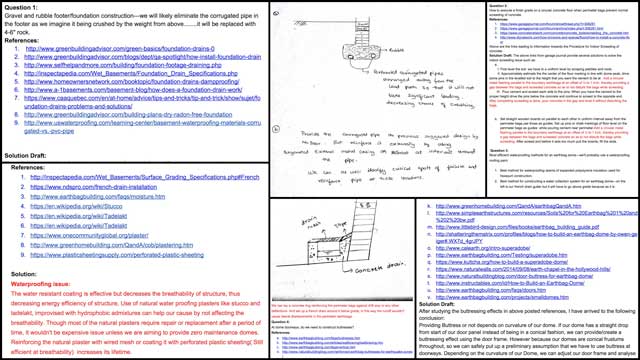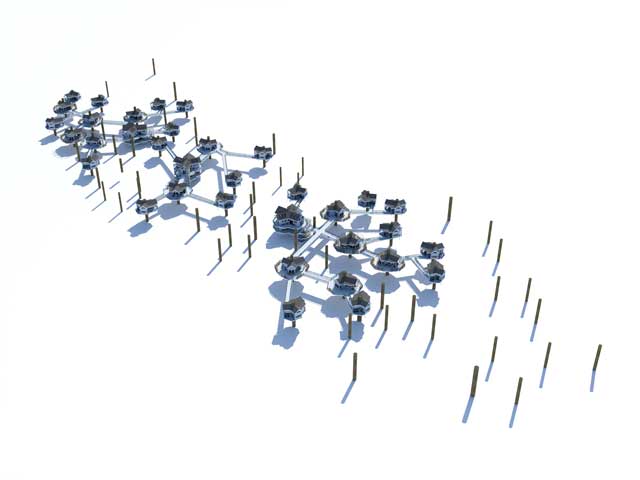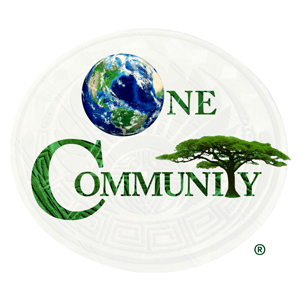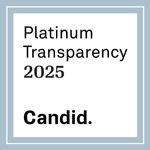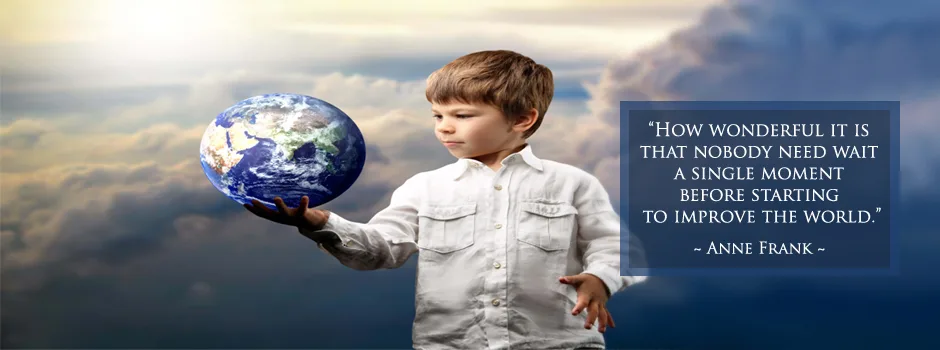
Eco-Community Support for Earth’s Biosphere – One Community Weekly Progress Update #236
Posted on October 1, 2017 by One Community
Eco-community support for Earth’s biosphere is one path to creating global sustainability. In support of this goal, One Community is creating open source and sustainable plans for all aspects of eco-community creation. These plans include food, energy, housing, education, for-profit and non-profit economic design, social architecture, fulfilled living, global stewardship practices, and more.
- Here’s our project overview
- Here’s our world-change methodology
- Here’s how this becomes self-replicating
- Here’s how we are open source and free-sharing all the do-it-yourself designs
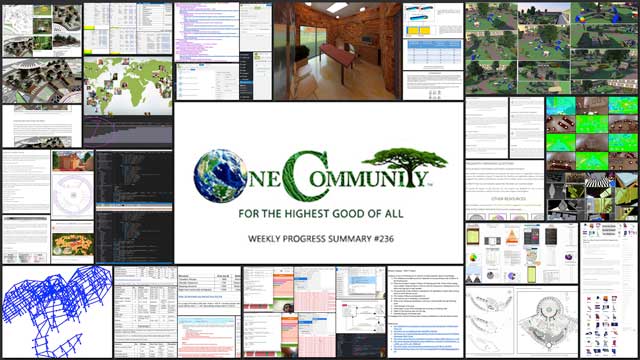
OUR MAIN OPEN SOURCE HUBS
Click on each icon to be taken to the corresponding Highest Good hub page.
One Community’s physical location will forward this movement as the first of many self-replicating teacher/demonstration communities, villages, and cities to be built around the world. This is the October 1, 2017 edition (#236) of our weekly progress update detailing our team’s development and accomplishments:
Eco-Community Support for Earth’s Biosphere
One Community Progress Update #236
Here is the bullet-point list of this last week’s design and progress discussed in detail in the video above:
ECO-COMMUNITY SUPPORT FOR EARTH’S BIOSPHERE INTRO: @0:34
HIGHEST GOOD HOUSING: @6:34
- Continued Sketchup design for the open source outdoor areas of the Recycled Materials Village (see below)
- Updated the Compressed Earth Block Village open source hub with the new floor plans (see below)
- Sangam Stanczak and the core team updated the Communal Eco-shower page (see below)
- Hemanth Kotaru completed his 9th week doing research and running calculations for the Earthbag Village (see below)
- Jagannathan Shankar Mahadevan completed his 3rd working on the Straw Bale Village cost analysis (see below)
- Hamilton Mateca created the final render of the Compressed Earth Block Village Massage and Treatment Room Looking North (see below)
- Aparna Tandon continued her work on the Compressed Earth Block Village external elements (see below)
- Samantha Robinson completed her 9th week working on the interior design for the living structure of the Tree House Village (see below)
DUPLICABLE CITY CENTER: @9:02
- Falgun Patel completed his 5th week continuing to review, run calculations, and update the specifics of the remote-energy setup plan so we can update the Highest Good energy page (see below)
- Dipti Dhondarkar continued with her 52nd week of work on the lighting specifics for the City Center (see below)
- Vamsi Pulugurtha continued work on basement heat transfer comparisons for the City Center Heating and Cooling open source hub (see below)
- Oruba Rabie officially took over working on the City Center structural engineering details (see below)
HIGHEST GOOD FOOD: @10:36
- Continued researching and organizing recently found resources for our Food Self-sufficiency Transition Plan page and Sustainable Food Nutrition Calculations page (see below)
HIGHEST GOOD EDUCATION: @11:07
- Finished rebuilding the education Evaluation and Evolution open source portal to reflect and be able to access the content created over the last few months in collaboration with Sangam Stanczak (see below)
HIGHEST GOOD SOCIETY: @11:42
- Continued developing the animation for our video that will feature where all our collaborators and volunteers are from (see below)
- Finished working on the new and standalone state-by-state resource page for the US Departments of Taxation (see below)
- Ashwin Patil continued with creation of the the Highest Good society search engine version 3.0 (see below)
- Sowmya Manohar returned to helping work on the Highest Good Network software (see below)
- Priti Kothari completed her 7th week helping with the Highest Good Network software (see below)
ECO-COMMUNITY SUPPORT FOR EARTH’S BIOSPHERE SUMMARY: @13:28
- How you can most help us right now and how anyone can help
CLICK HERE IF YOU’D LIKE TO RECEIVE AN EMAIL EACH WEEK WHEN WE RELEASE A NEW UPDATE
YOU CAN ALSO JOIN US THROUGH SOCIAL MEDIA
ONE COMMUNITY WEEKLY UPDATE DETAILS
HIGHEST GOOD HOUSING PROGRESS
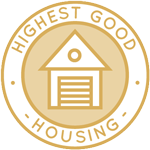 One Community is launching eco-community support for earth’s biosphere through Highest Good housing that is artistic and beautiful, more affordable, more space efficient, lasts longer, DIY buildable, and constructed with healthy and sustainable materials:
One Community is launching eco-community support for earth’s biosphere through Highest Good housing that is artistic and beautiful, more affordable, more space efficient, lasts longer, DIY buildable, and constructed with healthy and sustainable materials:
- Learn about: Our Upcoming Crowdfunding Campaign
- Learn about the different village models: 7 Sustainable Village Models
- Visit the open source portals for the first two: Earthbag Village OS Hub | Straw Bale Village OS Hub
This last week the core team continued Sketchup design for the open source outdoor areas of the Recycled Materials Village (Pod 6). This week we finished designing the outside dining area. We also updated the color of the building and worked on the landscaping.
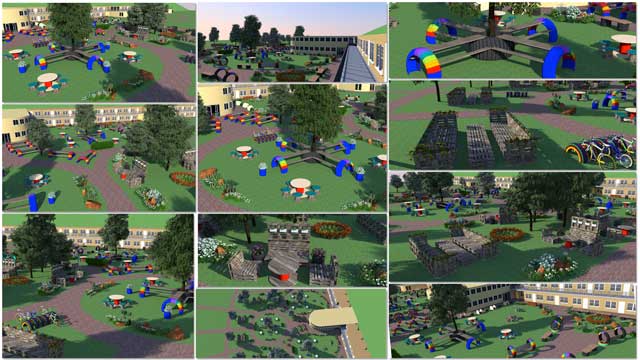
Eco-Community Support for Earth’s Biosphere – Outdoor Areas of Recycled Materials Village ” Click to Visit
The core team additionally updated the Compressed Earth Block Village open source hub with the new floor plans shown here. These include corrected patios for all three floors of the North residences.
The core team also, with the help of Sangam Stanczak (Ph.D. and P.E.), updated the Communal Eco-shower page with new biocompatible soap details, location and floor plan images, and copper-corrosion research results.
Hemanth Kotaru (Structural Engineering Masters Student) completed his 9th week with us doing research and running calculations for the Earthbag Village. This week’s focus, as shown here, was on researching the effectiveness of nails as an anti-sheer option between earthbags.
Jagannathan Shankar Mahadevan (Mechanical Engineer) completed his 3rd working on the Straw Bale Village cost analysis. What you see here are cost estimates for about half of the different areas included in this village.
Hamilton Mateca (AutoCAD and Revit Drafter and Designer) also finished his 57th week helping with the Compressed Earth Block Village design and render details. This week’s focus was this final render of the Massage and Treatment Room Looking North.
Aparna Tandon (Architect) continued her work on the Compressed Earth Block Village external elements. What you see here is her 35th week of work, focusing on the final presentation shown here and live on the site for the zone 11, the North Playground and Exercise Space.
Samantha Robinson (Graphic Designer) completed her 9th week working on the interior design for the living structure of the Tree House Village (Pod 7). This week’s focus, as shown here, was testing initial texturing for the upstairs shelving and more stair and furniture design details.
DUPLICABLE CITY CENTER PROGRESS
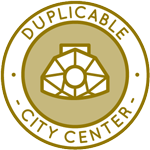 One Community is launching eco-community support for earth’s biosphere through a Duplicable and Sustainable City Center that is LEED Platinum certified/Sustainable, can feed 200 people at a time, provide laundry for over 300 people, is beautiful, spacious, and saves resources, money, and space:
One Community is launching eco-community support for earth’s biosphere through a Duplicable and Sustainable City Center that is LEED Platinum certified/Sustainable, can feed 200 people at a time, provide laundry for over 300 people, is beautiful, spacious, and saves resources, money, and space:
- Learn about this building and it’s function: Duplicable City Center Open Source Hub
Falgun Patel (Mechanical Engineer) completed his 5th week continuing to review, run calculations, and update the specifics of the remote-energy setup plan so we can update the Highest Good energy page. This week’s focus, as shown here, was 2nd-generation energy-needs calculations for the initial landing party, sizing the generators, and updating the landing-party-rollout text details.
Dipti Dhondarkar, (Electrical Engineer) continued with her 52nd week of work on the lighting specifics for the City Center. This week’s focus was adding and testing multiple lighting options for the Dining Dome column, wall, overhang, and table lights.
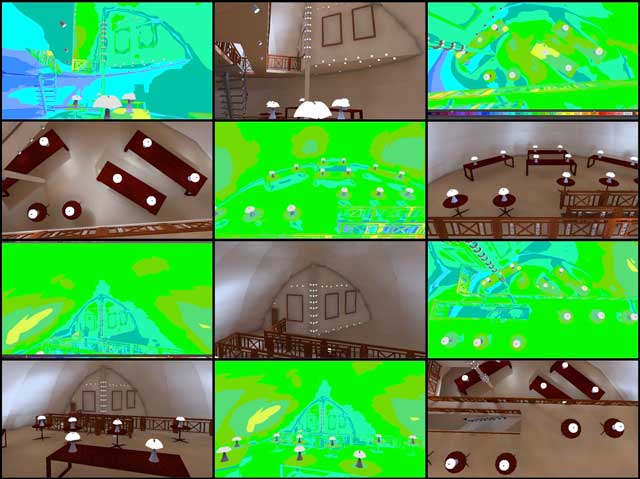
Eco-Community Support for Earth’s Biosphere – Lighting Specifics for the City Center ” Click for Page
Vamsi Pulugurtha (Mechanical Engineer) also continued work on basement heat transfer comparisons for the City Center Heating and Cooling open source hub. What you see here are Vamsi’s 4th-generation details and conclusions comparing how heat transfers from the basement and boiler room to the outside when built in-ground versus above ground.
Oruba Rabie (Ph.D, PE, and Civil Engineer) also officially took over working on the City Center structural engineering details. What you see here are some screenshots of her process looking for and correcting errors in the existing model.
HIGHEST GOOD FOOD PROGRESS
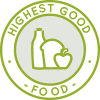 One Community is launching eco-community support for earth’s biosphere through Highest Good food that is more diverse, more nutritious, locally grown and sustainable, and part of our open source botanical garden model to support and share bio-diversity:
One Community is launching eco-community support for earth’s biosphere through Highest Good food that is more diverse, more nutritious, locally grown and sustainable, and part of our open source botanical garden model to support and share bio-diversity:
- Learn about the structures: Hoop House Hub | Aquapini & Walipini Open Source Hub
- See what we’ll be growing: Gardens & Hoop Houses | Large-scale Structures | Food Forest | TA
This week, the core team continued researching and organizing recently found resources for our Food Self-sufficiency Transition Plan and Sustainable Food Nutrition Calculations page, as you see here.
HIGHEST GOOD EDUCATION PROGRESS
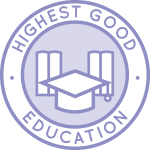 One Community is launching eco-community support for earth’s biosphere through Highest Good education that is for all ages, applicable in any environment, adaptable to individual needs, far exceeds traditional education standards, and more fun for both the teachers and the students:
One Community is launching eco-community support for earth’s biosphere through Highest Good education that is for all ages, applicable in any environment, adaptable to individual needs, far exceeds traditional education standards, and more fun for both the teachers and the students:
- Learn about the components: Education open source hub
- Learn how the components work together: How to use the Education for Life Program
This week, the core team finished rebuilding the education Evaluation and Evolution open source portal to reflect and be able to access the content created over the last few months in collaboration with Sangam Stanczak (Ph.D. and P.E.). You can see some of the new sections here.
HIGHEST GOOD SOCIETY PROGRESS
 One Community is launching eco-community support for earth’s biosphere through a Highest Good society approach to living that is founded on fulfilled living, the study of meeting human needs, Community, and making a difference in the world:
One Community is launching eco-community support for earth’s biosphere through a Highest Good society approach to living that is founded on fulfilled living, the study of meeting human needs, Community, and making a difference in the world:
- Read the Highest Good society overview: Highest Good Society
- Learn about the model for fulfilled living and sharing: A Day in the Life
- Learn about the 4 economic models: RBE | For-profit | Non-profit | Entrepreneurship
- Learn about our open source community collaboration and management software: The Highest Good Network
This last week the core team continued developing the animation for our video that will feature where all our collaborators and volunteers are from. The focus was adding the final image movements to bring us to 100% complete.

Eco-Community Support for Earth’s Biosphere – Graphic – Collaborators and Volunteers ” Click for Team
In addition to this we finished working on the new and standalone state-by-state resource page for the US Departments of Taxation, creating a header image, performing final edits, and completing the SEO information and sharing it. You can see this page here.
Ashwin Patil (Web Developer) continued with creation of the the Highest Good society search engine version 3.0, integrating another round of suggested edits and missing pages. You can see some of this work-in-progress here and we’d say this search engine is now 90% complete.
In addition to this, Sowmya Manohar (Software Engineer, Web Developer & Net Application Developer) returned to helping work on the Highest Good Network software. This week’s focus was continuing her work on the functions for retrieving account information for specific people based on individual IDs and populating the “Profile Page” for the specific person with their respective values.
In addition to this, Priti Kothari (Information Technology Enthusiast) also completed her 7th week helping with the Highest Good Network software. This week’s focus was experimenting with creating the database model design suitable for the application, some of which you can see here.
AND WE PRODUCED THIS WEEKLY UPDATES BLOG – CLICK HERE TO SUBSCRIBE
FOLLOW ONE COMMUNITY’S PROGRESS (click icons for our pages)
INVESTOR PAGES
GET INVOLVED
CONSULTANTS | WAYS ANYONE CAN HELP | MEMBERSHIP
CLICK HERE FOR ALL PAST UPDATES
WHAT ONE COMMUNITY IS CREATING
One Community is creating a place to grow together and change the world together thereby Creating a Better World and creating Eco-Community Support for Earth’s Biosphere.We are creating a space that helps each other live in integrity with each other and the planet as we strive to be the greatest versions of ourselves. We do this by harmoniously respecting each other, nature, and the rest of our one shared planet.
Our goal is to demonstrate what we feel is the most sustainable, healthy, and fun environment we can create. A place based on compassion, kindness, and collaboration. This replicable community will serve as an example for what is possible.
Throughout our design process we are open sourcing and free-sharing everything needed for construction and replication. This includes what we call “Highest Good” approaches to food, energy, housing, education, for-profit and non-profit economics design, social architecture, fulfilled living, stewardship practices and more. We are creating these resources for implementation as individual components or complete developments called teacher/demonstration hubs. These hubs will help launch additional hubs as awareness and knowledge grow.
BUILDING THE FIRST OF MANY
One Community will be the first teacher/demonstration hub. It will function as an experiential-learning model that facilitates mass participation to address humanity’s most pressing challenges through: A replicable model for expansion, building seven self-sufficient village/city prototypes, becoming the world leader in open-source sustainability solutions, and evolving and expanding ALL aspects of sustainable living.
WHY ONE COMMUNITY IS CREATING THIS
The One Community self-replicating model is capable of creating a sustainable planet within 30 years. We will achieve this by establishing successful teacher/demonstration hubs on every continent. Villages include designs appropriate for each of the five main types of climates. They also include options for even the most challenged economies. These hubs will collaborate with one another, share ideas, resources, and work together as a network to heal the planet. They will also transform the global lifestyle to a more enjoyable, fulfilling, healthy, and sustainable one.
The specifics of how One Community is accomplishing this can be found on the One Community Solution Model to Create Solution-creating Models Page. Research supporting and showing the benefits of a model like this can be found on our Research and Resources Articles Archive.
Even if we don’t achieve our ultimate goal of global transformation, a self-replicating teacher/demonstration model like this will take a relatively short period of time to positively affect millions while inspiring millions more. For One Community residents (the Pioneer Team), the idea of creating and sharing the social and recreational experience with visitors is also fun, exciting, fulfilling, and an additional reason why we are creating this.
SUMMARY
One Community sees the issues of the world as interdependent and interconnected. To address them simultaneously, we are open-source blueprinting a more advanced standard of living by designing holistic, environmentally-regenerative, self-sustaining, adaptable solutions for all areas of sustainability and Creating a Better World . We will model these within a comprehensive “village/city” which will be built in the southwestern U.S. This teacher/demonstration hub will be a place people can experience a new way of living and then replicate it with our open source blueprints: creating a model solution that creates additional solution-creating models.
Cultivation of Global Sustainability – One Community Weekly Progress Update #235
Posted on September 24, 2017 by One Community
One Community is focused on cultivation of global sustainability through sustainable and open source food, energy, housing, education, for-profit and non-profit economic design, social architecture, fulfilled living, global stewardship practices, and more. We call this living and creating for The Highest Good of All.
- Here’s our project overview
- Here’s our world-change methodology
- Here’s how this becomes self-replicating
- Here’s how we are open source and free-sharing all the do-it-yourself designs

OUR MAIN OPEN SOURCE HUBS
Click on each icon to be taken to the corresponding Highest Good hub page.
One Community’s physical location will forward this movement as the first of many self-replicating teacher/demonstration communities, villages, and cities to be built around the world. This is the September 24, 2017 edition (#235) of our weekly progress update detailing our team’s development and accomplishments:
Cultivation of Global Sustainability
One Community Progress Update #235
Here is the bullet-point list of this last week’s design and progress discussed in detail in the video above:
CULTIVATION OF GLOBAL SUSTAINABILITY INTRO: @0:34
HIGHEST GOOD HOUSING: @6:08
- Continued Sketchup design for the open source outdoor areas of the Recycled Materials Village (see below)
- Updated the Compressed Earth Block Village open source hub with new images, etc. (see below)
- Updated the Communal Eco-shower page, Control and Automation page, and thermostatic mixing valve pages, with the help of Sangam Stanczak, with new water and energy-saving details and strategies (see below)
- Hemanth Kotaru completed his 8th week with us doing research, running calculations, and creating updated AutoCAD drawings for the Earthbag Village specifics (see below)
- Jagannathan Shankar Mahadevan completed his 2nd week working on the Straw Bale Village cost analysis (see below)
- Hamilton Mateca finished his 56th week helping with the Compressed Earth Block Village design and render details (see below)
- Aparna Tandon continued her work on the Compressed Earth Block Village external elements (see below)
- Samantha Robinson completed her 8th week working on the interior design for the living structure of the Tree House Village (see below)
DUPLICABLE CITY CENTER: @8:51
- Falgun Patel completed his 4th week continuing to review, run calculations, and update the specifics of the remote-energy setup plan so we can update the Highest Good energy page (see below)
- Dipti Dhondarkar continued with her 51st week of work on the lighting specifics for the City Center (see below)
- Aravind Vasudevan continued his calculations and research for climate battery component of the City Center Heating and Cooling open source hub (see below)
- Vamsi Pulugurtha continued work on basement heat transfer comparisons for the City Center Heating and Cooling open source hub (see below)
HIGHEST GOOD FOOD: @10:22
- Continued researching details for our food needs to review the details for the Food Self-sufficiency Transition Plan (see below)
HIGHEST GOOD EDUCATION: @10:58
- Began rebuilding the education Evaluation and Evolution open source portal to reflect and be able to access the content created over the last few months in collaboration with Sangam Stanczak (see below)
HIGHEST GOOD SOCIETY: @11:32
- Invested several more hours developing the animation for our video that will feature where all our collaborators and volunteers are from (see below)
- Made the final changes and additions to the taxes page (see below)
- Continued working on the new and standalone state-by-state resource page for the US Departments of Taxation
- Priti Kothari completed her 6th week helping with the Highest Good Network software (see below)
CULTIVATION OF GLOBAL SUSTAINABILITY SUMMARY: @12:50
- How you can most help us right now and how anyone can help
CLICK HERE IF YOU’D LIKE TO RECEIVE AN EMAIL EACH WEEK WHEN WE RELEASE A NEW UPDATE
YOU CAN ALSO JOIN US THROUGH SOCIAL MEDIA
ONE COMMUNITY WEEKLY UPDATE DETAILS
HIGHEST GOOD HOUSING PROGRESS
 One Community is forwarding the cultivation of global sustainability through Highest Good housing that is artistic and beautiful, more affordable, more space efficient, lasts longer, DIY buildable, and constructed with healthy and sustainable materials:
One Community is forwarding the cultivation of global sustainability through Highest Good housing that is artistic and beautiful, more affordable, more space efficient, lasts longer, DIY buildable, and constructed with healthy and sustainable materials:
- Learn about: Our Upcoming Crowdfunding Campaign
- Learn about the different village models: 7 Sustainable Village Models
- Visit the open source portals for the first two: Earthbag Village OS Hub | Straw Bale Village OS Hub
The core team continued Sketchup design for the open source outdoor areas of the Recycled Materials Village (Pod 6). This week we added missing rails, doors and windows to the dining building, and updated the dining area walls with openings for the doors and windows on both floors.
The core team also continued working on the complete Tree House Village (Pod 7) village render, which is now approximately 90% complete and shown here as the 25%-smaller bottom version.
The core team additionally updated the Compressed Earth Block Village open source hub with new images, descriptions for all the images, formatting, and a new table of contents. You can see examples of the newly updated page and content here.

Cultivation of Global Sustainability – Compressed Earth Block Village Open source Hub – Click for Page
The core team also, with the help of Sangam Stanczak (Ph.D. and P.E.), updated the Communal Eco-shower page, Control and Automation page, and thermostatic mixing valve pages with new water and energy-saving details and strategies. You can see some of this work here.

Cultivation of Global Sustainability – Communal Eco-Shower, Control Automation Pages – Click to Visit
Hemanth Kotaru (Structural Engineering Masters Student) completed his 8th week with us doing research, running calculations, and creating updated AutoCAD drawings for the Earthbag Village specifics. You can see here some of this work along with the behind-the-scenes editing and revisions questions.

Cultivation of Global Sustainability – Research – AutoCAD Drawings – Earthbag Village – Click for Page
Jagannathan Shankar Mahadevan (Mechanical Engineer) completed his 2nd week working on the Straw Bale Village cost analysis. What you see here are outlines of the HVAC system and the beginnings of costing out the specifics for the residential sections of the village.

Cultivation of Global Sustainability – Continued Work – Straw Bale Village Cost Analysis – Click to Visit
Hamilton Mateca (AutoCAD and Revit Drafter and Designer) also finished his 56th week helping with the Compressed Earth Block Village design and render details. This week’s focus was version 2 and 3 of the massage room renders, as seen here.

Cultivation of Global Sustainability – Earth Block Village Design and Render details – Click for Page
Aparna Tandon (Architect) continued her work on the Compressed Earth Block Village external elements. What you see here is her 34th week of work, focusing on the final presentation shown here (and live on the site) for the zone 8 and 9 exercise and recreation areas.
Samantha Robinson (3D Designer) completed her 8th week working on the interior design for the living structure of the Tree House Village (Pod 7). This week’s focus, as shown here, was designing the railing specifics for the stairway.
DUPLICABLE CITY CENTER PROGRESS
 One Community is forwarding the cultivation of global sustainability through a Duplicable and Sustainable City Center that is LEED Platinum certified/Sustainable, can feed 200 people at a time, provide laundry for over 300 people, is beautiful, spacious, and saves resources, money, and space:
One Community is forwarding the cultivation of global sustainability through a Duplicable and Sustainable City Center that is LEED Platinum certified/Sustainable, can feed 200 people at a time, provide laundry for over 300 people, is beautiful, spacious, and saves resources, money, and space:
- Learn about this building and it’s function: Duplicable City Center Open Source Hub
Falgun Patel (Mechanical Engineer) completed his 4th week continuing to review, run calculations, and update the specifics of the remote-energy setup plan so we can update the Highest Good energy page. This week’s focus, as shown here, was detailed energy-needs calculations for the initial construction equipment, Transition Kitchen, and Ultimate Classroom.
Dipti Dhondarkar, (Electrical Engineer) continued with her 51st week of work on the lighting specifics for the City Center. This week’s focus was testing multiple angles and finalizing the Dining Dome flood light placement, as shown here.

Cultivation of Global Sustainability – Continued Work Lighting Specifics for City Center ” Click for Page
Aravind Vasudevan (Mechanical Engineer) continued his calculations and research for climate battery component of the City Center Heating and Cooling open source hub. This week’s focus was creation of the initial presentation structure we’re evolving into the complete design, as shown here.

Cultivation of Global Sustainability – Climate Battery Component of City Center ” Click to Visit Page
Vamsi Pulugurtha (Mechanical Engineer) also continued work on basement heat transfer comparisons for the City Center Heating and Cooling open source hub. What you see here is Vamsi’s newest details and conclusions comparing how heat transfers from the basement and boiler room to the outside when built in-ground versus above ground.
HIGHEST GOOD FOOD PROGRESS
 One Community is forwarding the cultivation of global sustainability through Highest Good food that is more diverse, more nutritious, locally grown and sustainable, and part of our open source botanical garden model to support and share bio-diversity:
One Community is forwarding the cultivation of global sustainability through Highest Good food that is more diverse, more nutritious, locally grown and sustainable, and part of our open source botanical garden model to support and share bio-diversity:
- Learn about the structures: Hoop House Hub | Aquapini & Walipini Open Source Hub
- See what we’ll be growing: Gardens & Hoop Houses | Large-scale Structures | Food Forest | TA
This week, the core team continued editing the food pages. We continued researching details for our food needs to review the details for the Food Self-sufficiency Transition Plan and found 31 additional resources for checking calculations on the Sustainable Food Nutrition Calculations page, as you see here.
HIGHEST GOOD EDUCATION PROGRESS
 One Community is forwarding the cultivation of global sustainability through Highest Good education that is for all ages, applicable in any environment, adaptable to individual needs, far exceeds traditional education standards, and more fun for both the teachers and the students:
One Community is forwarding the cultivation of global sustainability through Highest Good education that is for all ages, applicable in any environment, adaptable to individual needs, far exceeds traditional education standards, and more fun for both the teachers and the students:
- Learn about the components: Education open source hub
- Learn how the components work together: How to use the Education for Life Program
This week, the core team began rebuilding the education Evaluation and Evolution open source portal to reflect and be able to access the content created over the last few months in collaboration with Sangam Stanczak (Ph.D. and P.E.). You can see some of this work-in-progress here.

Cultivation of Global Sustainability – Rebuilding Education, Evaluation, Evolution Portal – Click for Page
HIGHEST GOOD SOCIETY PROGRESS
 One Community is forwarding the cultivation of global sustainability through a Highest Good society approach to living that is founded on fulfilled living, the study of meeting human needs, Community, and making a difference in the world:
One Community is forwarding the cultivation of global sustainability through a Highest Good society approach to living that is founded on fulfilled living, the study of meeting human needs, Community, and making a difference in the world:
- Read the Highest Good society overview: Highest Good Society
- Learn about the model for fulfilled living and sharing: A Day in the Life
- Learn about the 4 economic models: RBE | For-profit | Non-profit | Entrepreneurship
- Learn about our open source community collaboration and management software: The Highest Good Network
This week the core team invested several more hours developing the animation for our video that will feature where all our collaborators and volunteers are from. The focus was developing the image movements and we are now approximately 50% complete.

Cultivation of Global Sustainability – Graphic Showing Our Collaborators, Volunteers ” Click for Team
The core team also made the final changes and additions to the taxes page, bringing it to 100% completion.

Cultivation of Global Sustainability – Made Final Changes and Completed the Taxes Page – Click to Visit
In addition to this we continued working on the new and standalone state-by-state resource page for the US Departments of Taxation, creating all the text, fixing all the image links on the page, and adding in SEO information. You can see some of this page-in-progress here.
In addition to this, Priti Kothari (Information Technology Enthusiast) also completed her 6th week helping with the Highest Good Network software. This week’s focus was successfully getting the “D3” software to create the horizontal bar chart in the leaderboard based on the hard coded model data. You can see some of this work here.

Cultivation of Global Sustainability – Continued Work – Highest Good Network Software – Click to Visit
AND WE PRODUCED THIS WEEKLY UPDATES BLOG – CLICK HERE TO SUBSCRIBE
FOLLOW ONE COMMUNITY’S PROGRESS (click icons for our pages)
INVESTOR PAGES
GET INVOLVED
CONSULTANTS | WAYS ANYONE CAN HELP | MEMBERSHIP
CLICK HERE FOR ALL PAST UPDATES
WHAT ONE COMMUNITY IS CREATING
One Community is creating a place to grow together and change the world together thereby Creating a Better World and setting up the Global Conservation Plan.We are creating a space that helps each other live in integrity with each other and the planet as we strive to be the greatest versions of ourselves. We do this by harmoniously respecting each other, nature, and the rest of our one shared planet.
Our goal is to demonstrate what we feel is the most sustainable, healthy, and fun environment we can create. A place based on compassion, kindness, and collaboration. This replicable community will serve as an example for what is possible.
Throughout our design process we are open sourcing and free-sharing everything needed for construction and replication. This includes what we call “Highest Good” approaches to food, energy, housing, education, for-profit and non-profit economics design, social architecture, fulfilled living, stewardship practices and more. We are creating these resources for implementation as individual components or complete developments called teacher/demonstration hubs. These hubs will help launch additional hubs as awareness and knowledge grow.
BUILDING THE FIRST OF MANY
One Community will be the first teacher/demonstration hub. It will function as an experiential-learning model that facilitates mass participation to address humanity’s most pressing challenges through: A replicable model for expansion, building seven self-sufficient village/city prototypes, becoming the world leader in open-source sustainability solutions, and evolving and expanding ALL aspects of sustainable living.
WHY ONE COMMUNITY IS CREATING THIS
The One Community self-replicating model is capable of creating a sustainable planet within 30 years. We will achieve this by establishing successful teacher/demonstration hubs on every continent. Villages include designs appropriate for each of the five main types of climates. They also include options for even the most challenged economies. These hubs will collaborate with one another, share ideas, resources, and work together as a network to heal the planet. They will also transform the global lifestyle to a more enjoyable, fulfilling, healthy, and sustainable one.
The specifics of how One Community is accomplishing this can be found on the One Community Solution Model to Create Solution-creating Models Page. Research supporting and showing the benefits of a model like this can be found on our Research and Resources Articles Archive.
Even if we don’t achieve our ultimate goal of global transformation, a self-replicating teacher/demonstration model like this will take a relatively short period of time to positively affect millions while inspiring millions more. For One Community residents (the Pioneer Team), the idea of creating and sharing the social and recreational experience with visitors is also fun, exciting, fulfilling, and an additional reason why we are creating this.
SUMMARY
One Community sees the issues of the world as interdependent and interconnected. To address them simultaneously, we are open-source blueprinting a more advanced standard of living by designing holistic, environmentally-regenerative, self-sustaining, adaptable solutions for all areas of sustainability and Creating a Better World . We will model these within a comprehensive “village/city” which will be built in the southwestern U.S. This teacher/demonstration hub will be a place people can experience a new way of living and then replicate it with our open source blueprints: creating a model solution that creates additional solution-creating models.
One Community Welcomes Sam Robinson to the Graphic Design Team
Posted on September 22, 2017 by One Community
One Community welcomes Sam Robinson to the Graphics Team as our newest Volunteer/Consultant!

3D Designer: Sam has a B.S. in Game Arts & Design from The Art Institute of Pittsburgh. Ever since Sam was a 12-years old, she has wanted to become a 3D designer for levels and objects/assets for video games, and maybe someday, bring her own ideas to life. To this day, she is determined to grow as a designer and earn her way into the industry. Sam believes that without sustainability, there would be no balance in the quality of life and the world around it. As a member of the One Community Team, Sam is applying her 3D design skills to help with the internal renders for the Tree House Village.
WELCOME TO THE TEAM SAM!
FOLLOW ONE COMMUNITY’S PROGRESS (click icons for our pages)
INVESTOR PAGES
GET INVOLVED
Global Conservation Plan – One Community Weekly Progress Update #234
Posted on September 17, 2017 by One Community
A global conservation plan is needed if humanity is going to achieve sustainability. One Community is helping create this by open sourcing sustainable approaches to every area of civilization that we see as essential. These areas include food, energy, housing, education, for-profit and non-profit economic design, social architecture, fulfilled living, global stewardship practices, and more. We call this living and creating for The Highest Good of All.
- Here’s our project overview
- Here’s our world-change methodology
- Here’s how this becomes self-replicating
- Here’s how we are open source and free-sharing all the do-it-yourself designs

OUR MAIN OPEN SOURCE HUBS
Click on each icon to be taken to the corresponding Highest Good hub page.
One Community’s physical location will forward this movement as the first of many self-replicating teacher/demonstration communities, villages, and cities to be built around the world. This is the September 17, 2017 edition (#234) of our weekly progress update detailing our team’s development and accomplishments:
Global Conservation Plan
One Community Progress Update #234
Here is the bullet-point list of this last week’s design and progress discussed in detail in the video above:
GLOBAL CONSERVATION PLAN INTRO: @0:34
HIGHEST GOOD HOUSING: @7:39
- Continued Sketchup design for the open source outdoor areas of the Recycled Materials Village (see below)
- Continued working on the complete Tree House Village (Pod 7) village render (see below)
- Jagannathan Shankar Mahadevan joined the team and completed his 1st week familiarizing himself with the Straw Bale Village and researching the details needed to compile a total-village cost analysis (see below)
- Hamilton Mateca finished his 55th week helping with the Compressed Earth Block Village design and render details (see below)
- Aparna Tandon continued her work on the Compressed Earth Block Village external elements (see below)
- Samantha Robinson completed her 7th week working on the interior design for the living structure of the Tree House Village (see below)
DUPLICABLE CITY CENTER: @9:40
- Falgun Patel completed his 3rd week continuing to review, run calculations, and update the specifics of the remote-energy setup plan so we can update the Highest Good energy page (see below)
- Dipti Dhondarkar continued with her 50th week of work on the lighting specifics for the City Center (see below)
- Renan Dantas continued with his 19th week working on the Duplicable City CenterAutoCAD updates (see below)
- Aravind Vasudevan continued his calculations and research for climate battery component of the City Center Heating and Cooling open source hub (see below)
- Vamsi Pulugurtha continued work on the thermal lag research and reports for the City Center Heating and Cooling open source hub (see below)
HIGHEST GOOD FOOD: @11:18
- Researched details for our food needs to review the details for the Food Self-sufficiency Transition Plan (see below)
HIGHEST GOOD EDUCATION: @11:52
- Working with Sangam Stanczak, the core team added a What and Why section, updated formatting, and new table of contents to the Teaching Strategies for Life page (see below)
HIGHEST GOOD SOCIETY: @12:30
- Continued developing the graphic showing where all our collaborators and volunteers are from (see below)
- Continued working on proofreading and updating the formatting for the taxes page (see below)
- Continued reviewing the Highest Good society search engine version 2.0 details, checking links, formatting, titles and other details so Ashwin Patil can continue the process of finishing this amazing tool (see below)
- Priti Kothari completed her 5th week helping with the Highest Good Network software (see below)
GLOBAL CONSERVATION PLAN SUMMARY: @14:13
- How you can most help us right now and how anyone can help
CLICK HERE IF YOU’D LIKE TO RECEIVE AN EMAIL EACH WEEK WHEN WE RELEASE A NEW UPDATE
YOU CAN ALSO JOIN US THROUGH SOCIAL MEDIA
ONE COMMUNITY WEEKLY UPDATE DETAILS
HIGHEST GOOD HOUSING PROGRESS
 One Community is designing a global conservation plan through Highest Good housing that is artistic and beautiful, more affordable, more space efficient, lasts longer, DIY buildable, and constructed with healthy and sustainable materials:
One Community is designing a global conservation plan through Highest Good housing that is artistic and beautiful, more affordable, more space efficient, lasts longer, DIY buildable, and constructed with healthy and sustainable materials:
- Learn about: Our Upcoming Crowdfunding Campaign
- Learn about the different village models: 7 Sustainable Village Models
- Visit the open source portals for the first two: Earthbag Village OS Hub | Straw Bale Village OS Hub
This week the core team continued Sketchup design for the open source outdoor areas of the Recycled Materials Village (Pod 6). We finalized 8 new renders of the outdoor Art and Library Areas and added the images to the site. Here are the images showing several different perspectives for each of these two areas that function as outdoor extensions of the indoor spaces purposed for the same use.
The core team also continued working on the complete Tree House Village (Pod 7) village render, which is now approximately 80% complete and shown here.
Jagannathan Shankar Mahadevan (Mechanical Engineer) also joined the team and completed his 1st week familiarizing himself with the Straw Bale Village and researching the details needed to compile a total-village cost analysis.

Global Conservation Plan – Research – Total-Village Cost Analysis of Straw Bale Village – Click for Page
Hamilton Mateca (AutoCAD and Revit Drafter and Designer) also finished his 55th week helping with the Compressed Earth Block Village design and render details. This week’s focus was finishing the final kitchen render looking North, as shown here and now live on the website too.
Aparna Tandon (Architect) continued her work on the Compressed Earth Block Village external elements. What you see here is her 33rd week of work, focusing on the final presentation shown here (and live on the site) for the central area between the North and South residential wings.
Samantha Robinson (3D Designer) completed her 7th week working on the interior design for the living structure of the Tree House Village (Pod 7). This week’s focus, as shown here, was revisions for the drawers under the bed, adjustments to the floor plan, and working on the stairway railing details.
DUPLICABLE CITY CENTER PROGRESS
 One Community is designing a global conservation plan through a Duplicable and Sustainable City Center that is LEED Platinum certified/Sustainable, can feed 200 people at a time, provide laundry for over 300 people, is beautiful, spacious, and saves resources, money, and space:
One Community is designing a global conservation plan through a Duplicable and Sustainable City Center that is LEED Platinum certified/Sustainable, can feed 200 people at a time, provide laundry for over 300 people, is beautiful, spacious, and saves resources, money, and space:
- Learn about this building and it’s function: Duplicable City Center Open Source Hub
Falgun Patel (Mechanical Engineer) completed his 3rd week continuing to review, run calculations, and update the specifics of the remote-energy setup plan so we can update the Highest Good energy page. You can see some of this last week’s work here.
Dipti Dhondarkar, (Electrical Engineer) continued with her 50th week of work on the lighting specifics for the City Center. This week’s focus was continuing to model the Dining Dome in preparation for applying and testing the best of the lighting designs from the Social Dome.
Renan Dantas (Mechanical Engineer) continued with his 19th week working on the Duplicable City Center AutoCAD updates. This week’s focus was reviewing the complete window and door plan to simplify and improve it.
Aravind Vasudevan (Mechanical Engineer) continued his calculations and research for climate battery component of the City Center Heating and Cooling open source hub. You can see here his fan-use break-even cost analysis and some of his hand calculations related to this.
Vamsi Pulugurtha (Mechanical Engineer) also continued work on the thermal lag research and reports for the City Center Heating and Cooling open source hub. What you see here is Vamsi’s work comparing how heat transfers from the basement and boiler room to the outside when built in-ground versus above ground.
HIGHEST GOOD FOOD PROGRESS
 One Community is designing a global conservation plan through Highest Good food that is more diverse, more nutritious, locally grown and sustainable, and part of our open source botanical garden model to support and share bio-diversity:
One Community is designing a global conservation plan through Highest Good food that is more diverse, more nutritious, locally grown and sustainable, and part of our open source botanical garden model to support and share bio-diversity:
- Learn about the structures: Hoop House Hub | Aquapini & Walipini Open Source Hub
- See what we’ll be growing: Gardens & Hoop Houses | Large-scale Structures | Food Forest | TA
This week, the core team continued editing the food pages. We researched details for our food needs to review the details for the Food Self-sufficiency Transition Plan and found 38 resources for checking calculations on the Sustainable Food Nutrition Calculations page, as you see here.
HIGHEST GOOD EDUCATION PROGRESS
 One Community is designing a global conservation plan through Highest Good education that is for all ages, applicable in any environment, adaptable to individual needs, far exceeds traditional education standards, and more fun for both the teachers and the students:
One Community is designing a global conservation plan through Highest Good education that is for all ages, applicable in any environment, adaptable to individual needs, far exceeds traditional education standards, and more fun for both the teachers and the students:
- Learn about the components: Education open source hub
- Learn how the components work together: How to use the Education for Life Program
This week, the core team working with Sangam Stanczak (Ph.D. and P.E.), added a What and Why section, updated formatting, and new table of contents to the Teaching Strategies for Life page. This completes this page’s update to the newest formatting we’re using for all the other pages of the site.
HIGHEST GOOD SOCIETY PROGRESS
 One Community is designing a global conservation plan through a Highest Good society approach to living that is founded on fulfilled living, the study of meeting human needs, Community, and making a difference in the world:
One Community is designing a global conservation plan through a Highest Good society approach to living that is founded on fulfilled living, the study of meeting human needs, Community, and making a difference in the world:
- Read the Highest Good society overview: Highest Good Society
- Learn about the model for fulfilled living and sharing: A Day in the Life
- Learn about the 4 economic models: RBE | For-profit | Non-profit | Entrepreneurship
- Learn about our open source community collaboration and management software: The Highest Good Network
This week the core team invested several more hours developing the graphic showing where all our collaborators and volunteers are from. The focus was adding three more volunteers into their respective locations in the master layer for the video map, and creating and adding an enhanced web version to the team page.
The core team also continued working on proofreading and updating the formatting for the taxes page. We checked for errors in spelling, punctuation, image placement and functionality, and checked all of the ~300 different hyperlinks. We also created the beginnings of a new and standalone state-by-state resource page for the US Departments of Taxation, which will be a useful page that anyone can find via a Google search.
The core team also continued reviewing the Highest Good society search engine version 2.0 details, checking links, formatting, titles and other details so Ashwin Patil (Web Developer) can continue the process of finishing this amazing tool. You can see some of this work-in-progress here and we’d say this search engine is now 70% complete.
In addition to this, Priti Kothari (Information Technology Enthusiast) also completed her 5th week helping with the Highest Good Network software. This week’s focus was researching, testing, and debugging the “D3” software we’ll be using to create the Leaderboard charts of everyone’s hours. You can see some of this work here.
AND WE PRODUCED THIS WEEKLY UPDATES BLOG – CLICK HERE TO SUBSCRIBE
FOLLOW ONE COMMUNITY’S PROGRESS (click icons for our pages)
INVESTOR PAGES
GET INVOLVED
CONSULTANTS | WAYS ANYONE CAN HELP | MEMBERSHIP
CLICK HERE FOR ALL PAST UPDATES
WHAT ONE COMMUNITY IS CREATING
One Community is creating a place to grow together and change the world together thereby Creating a Better World and setting up the Global Conservation Plan.We are creating a space that helps each other live in integrity with each other and the planet as we strive to be the greatest versions of ourselves. We do this by harmoniously respecting each other, nature, and the rest of our one shared planet.
Our goal is to demonstrate what we feel is the most sustainable, healthy, and fun environment we can create. A place based on compassion, kindness, and collaboration. This replicable community will serve as an example for what is possible.
Throughout our design process we are open sourcing and free-sharing everything needed for construction and replication. This includes what we call “Highest Good” approaches to food, energy, housing, education, for-profit and non-profit economics design, social architecture, fulfilled living, stewardship practices and more. We are creating these resources for implementation as individual components or complete developments called teacher/demonstration hubs. These hubs will help launch additional hubs as awareness and knowledge grow.
BUILDING THE FIRST OF MANY
One Community will be the first teacher/demonstration hub. It will function as an experiential-learning model that facilitates mass participation to address humanity’s most pressing challenges through: A replicable model for expansion, building seven self-sufficient village/city prototypes, becoming the world leader in open-source sustainability solutions, and evolving and expanding ALL aspects of sustainable living.
WHY ONE COMMUNITY IS CREATING THIS
The One Community self-replicating model is capable of creating a sustainable planet within 30 years. We will achieve this by establishing successful teacher/demonstration hubs on every continent. Villages include designs appropriate for each of the five main types of climates. They also include options for even the most challenged economies. These hubs will collaborate with one another, share ideas, resources, and work together as a network to heal the planet. They will also transform the global lifestyle to a more enjoyable, fulfilling, healthy, and sustainable one.
The specifics of how One Community is accomplishing this can be found on the One Community Solution Model to Create Solution-creating Models Page. Research supporting and showing the benefits of a model like this can be found on our Research and Resources Articles Archive.
Even if we don’t achieve our ultimate goal of global transformation, a self-replicating teacher/demonstration model like this will take a relatively short period of time to positively affect millions while inspiring millions more. For One Community residents (the Pioneer Team), the idea of creating and sharing the social and recreational experience with visitors is also fun, exciting, fulfilling, and an additional reason why we are creating this.
SUMMARY
One Community sees the issues of the world as interdependent and interconnected. To address them simultaneously, we are open-source blueprinting a more advanced standard of living by designing holistic, environmentally-regenerative, self-sustaining, adaptable solutions for all areas of sustainability and Creating a Better World . We will model these within a comprehensive “village/city” which will be built in the southwestern U.S. This teacher/demonstration hub will be a place people can experience a new way of living and then replicate it with our open source blueprints: creating a model solution that creates additional solution-creating models.
Systems for Eco-Freedom – One Community Weekly Progress Update #233
Posted on September 10, 2017 by One Community
Systems for eco-freedom are also systems for creating global sustainability. These systems are about freedom through replicable and do-it-yourself models for food, energy, and housing self-sufficiency and sustainability. One Community is also designing them to cover education, for-profit and non-profit economic design, social architecture, fulfilled living practices, and global stewardship models. Combined, we call this living and creating for The Highest Good of All.
- Here’s our project overview
- Here’s our world-change methodology
- Here’s how this becomes self-replicating
- Here’s how we are open source and free-sharing all the do-it-yourself designs

OUR MAIN OPEN SOURCE HUBS
Click on each icon to be taken to the corresponding Highest Good hub page.
One Community’s physical location will forward this movement as the first of many self-replicating teacher/demonstration communities, villages, and cities to be built around the world. This is the September 10, 2017 edition (#233) of our weekly progress update detailing our team’s development and accomplishments:
Systems for Eco-Freedom
One Community Progress Update #233
Here is the bullet-point list of this last week’s design and progress discussed in detail in the video above:
SYSTEMS FOR ECO-FREEDOM INTRO: @0:34
HIGHEST GOOD HOUSING: @6:52
- Continued Sketchup design for the open source outdoor areas of the Recycled Materials Village (see below)
- Added 3 final Tree House Village (Pod 7) renders to the page and began working on the complete village render (see below)
- Updated Cob Village open source hub to include summary introductions to all the image sections (see below)
- Dijimba “Joss” Kabuyi Ilunga completed his final week working on the electrical design details for the Vermiculture Bathrooms (see below)
- Hemanth Kotaru completed his 6th week with us by conducting additional Earthbag Village construction research (see below)
- Christian Ojeda completed his 26th week helping with the plumbing details for the heat-recycling Communal Eco-shower, Vermiculture Bathroom, and Net-zero Communal Bathroom Designs (see below)
- Dean Scholz continued helping us create quality Cob Village renders
- Hamilton Mateca finished his 54th week helping with the Compressed Earth Block Village design and render details (see below)
- Guy Grossfeld continued helping with the Tree House Village renders (see below)
- Samantha Robinson completed her 6th week working on the interior design for the living structure of the Tree House Village (see below)
DUPLICABLE CITY CENTER: @10:05
- Falgun Patel began the process of reviewing the specifics of the remote-energy setup plan and starting the calculations to confirm the energy-needs details so we can update the Highest Good energy page (see below)
- Haoxuan “Hayes” Lei continued work on the City Center structural engineering tutorial (see below)
- Dipti Dhondarkar continued with her 49th week of work on the lighting specifics for the City Center (see below)
- Renan Dantas continued with his 18th week working on the Duplicable City Center AutoCAD updates
- Vamsi Pulugurtha continued work on the thermal lag research and reports for the City Center Heating and Cooling open source hub (see below)
HIGHEST GOOD FOOD: @11:40
- Recalculated food needs and created replacement charts for the Food Procurement and Storage Plan and the Food Self-sufficiency Transition Plan pages (see below)
HIGHEST GOOD EDUCATION: @12:11
- Completed the process of a final proofreading and editing of all 52 lesson plans (see below)
- Completed a full-page update for the Reggio teaching methodology page (see below)
HIGHEST GOOD SOCIETY: @13:02
- Invested several more hours developing the graphic showing where all our collaborators and volunteers are from (see below)
- Created a new and updated summary video (see below)
- Worked on proofreading and updating the formatting for the taxes page (see below)
SYSTEMS FOR ECO-FREEDOM SUMMARY: @14:12
- How you can most help us right now and how anyone can help
CLICK HERE IF YOU’D LIKE TO RECEIVE AN EMAIL EACH WEEK WHEN WE RELEASE A NEW UPDATE
YOU CAN ALSO JOIN US THROUGH SOCIAL MEDIA
ONE COMMUNITY WEEKLY UPDATE DETAILS
HIGHEST GOOD HOUSING PROGRESS
 One Community is creating systems for eco-freedom through Highest Good housing that is artistic and beautiful, more affordable, more space efficient, lasts longer, DIY buildable, and constructed with healthy and sustainable materials:
One Community is creating systems for eco-freedom through Highest Good housing that is artistic and beautiful, more affordable, more space efficient, lasts longer, DIY buildable, and constructed with healthy and sustainable materials:
- Learn about: Our Upcoming Crowdfunding Campaign
- Learn about the different village models: 7 Sustainable Village Models
- Visit the open source portals for the first two: Earthbag Village OS Hub | Straw Bale Village OS Hub
This week the core team continued Sketchup design for the open source outdoor areas of the Recycled Materials Village (Pod 6). We completed the table with benches by adding flower boxes on each side, support rails underneath the tables, and backs to the benches. We also designed a single-person cable spoon bench, set up the library outside furniture layer, and placed plants around the library area.
The core team also added 3 final Tree House Village (Pod 7) renders to the page and began working on the complete village render, which is now approximately 15% complete.
In addition to this, we updated the Cob Village (Pod 3) open source hub to include summary introductions to all the image sections, as shown here.
Dijimba “Joss” Kabuyi Ilunga (Electrical Engineer) completed his final week working on the electrical design details for the Vermiculture Bathrooms. Joss finished the designs in AutoCAD and wrote the summary of his work. This brings the electrical designs for this structure to 100% complete.
Hemanth Kotaru (Structural Engineering Masters Student) completed his 6th week with us by conducting additional Earthbag Village construction research. This week’s focus was finalizing the research and summaries of findings for the french drain, indoor floor screeding, and optimal bag thickness.
And Christian Ojeda (Mechatronic Engineer) completed his 26th week helping with the plumbing details for the heat-recycling Communal Eco-shower, Vermiculture Bathroom, and Net-zero Communal Bathroom Designs. This week’s work was increasing wall thicknesses in the shower to 6″ to accommodate the plumbing, adding basement drains to all 3 structures, and more piping updates. This brings us to 98% complete with the plumbing for the whole Earthbag Village.
Dean Scholz (Architectural Designer) continued helping us create quality Cob Village (Pod 3) renders. Here is update 83 of Dean’s work, continuing to test and develop the textures and lighting from the skylights and windows for the central dining and presentation hall.
Hamilton Mateca (AutoCAD and Revit Drafter and Designer) also finished his 54th week helping with the Compressed Earth Block Village design and render details. This week’s focus was beginning work on the final kitchen render looking North, as shown here.
Guy Grossfeld (Graphic Designer) continued helping with the Tree House Village (Pod 7) renders. This week’s focus was completing the initial stairway and artistic tree elements for inside the living structures, as shown here.
Samantha Robinson (3D Designer) completed her 6th week working on the interior design for the living structure of the Tree House Village (Pod 7). This week’s focus, as shown here, was more shelving revisions for behind the bed, adding drawers under the bed, and more custom door design details.
DUPLICABLE CITY CENTER PROGRESS
 One Community is creating systems for eco-freedom through a Duplicable and Sustainable City Center that is LEED Platinum certified/Sustainable, can feed 200 people at a time, provide laundry for over 300 people, is beautiful, spacious, and saves resources, money, and space:
One Community is creating systems for eco-freedom through a Duplicable and Sustainable City Center that is LEED Platinum certified/Sustainable, can feed 200 people at a time, provide laundry for over 300 people, is beautiful, spacious, and saves resources, money, and space:
- Learn about this building and it’s function: Duplicable City Center Open Source Hub
Falgun Patel (Mechanical Engineer) completed his 2nd week volunteering. This week’s focus was beginning the process of reviewing the specifics of the remote-energy setup plan and starting the calculations to confirm the energy-needs details so we can update the Highest Good energy page.
Haoxuan “Hayes” Lei (Structural Engineer) continued work on the City Center structural engineering tutorial. What you see here is his 6th week of writing content. This week’s content focus was pressure coefficients and considerations.
Dipti Dhondarkar, (Electrical Engineer) continued with her 49th week of work on the lighting specifics for the City Center. This week’s focus was adding in the pool and walkway lighting details for the Social Dome and beginning to model the Dining Dome, as shown here.
Renan Dantas (Mechanical Engineer) continued with his 18th week working on the Duplicable City Center AutoCAD updates. This week’s focus was the under-stair locker and rinse-shower details shown in the sections here.
Vamsi Pulugurtha (Mechanical Engineer) also continued work on the thermal lag research and reports for the City Center Heating and Cooling open source hub. What you see here are Vamsi’s calculations showing how heat from the basement and boiler room transfers into and through the soil around these areas.
HIGHEST GOOD FOOD PROGRESS
 One Community is creating systems for eco-freedom through Highest Good food that is more diverse, more nutritious, locally grown and sustainable, and part of our open source botanical garden model to support and share bio-diversity:
One Community is creating systems for eco-freedom through Highest Good food that is more diverse, more nutritious, locally grown and sustainable, and part of our open source botanical garden model to support and share bio-diversity:
- Learn about the structures: Hoop House Hub | Aquapini & Walipini Open Source Hub
- See what we’ll be growing: Gardens & Hoop Houses | Large-scale Structures | Food Forest | TA
This week, the core team continued editing the food pages. We recalculated food needs and created replacement charts for the Food Procurement and Storage Plan and the Food Self-sufficiency Transition Plan pages, as you see here.
HIGHEST GOOD EDUCATION PROGRESS
 One Community is creating systems for eco-freedom through Highest Good education that is for all ages, applicable in any environment, adaptable to individual needs, far exceeds traditional education standards, and more fun for both the teachers and the students:
One Community is creating systems for eco-freedom through Highest Good education that is for all ages, applicable in any environment, adaptable to individual needs, far exceeds traditional education standards, and more fun for both the teachers and the students:
- Learn about the components: Education open source hub
- Learn how the components work together: How to use the Education for Life Program
This week, the core team continued the process of a final proofreading and editing of all 52 lesson plans. This week we completed the final two lesson plans, the Consensus and Decision Making Lesson Plan and the Contribution Lesson Plan. This brings us to 52 of 52 finished, which is 100% completion!
The core team also completed a full-page update for the Reggio teaching methodology page. This included integrating all our research from two weeks ago, adding a new resource section, and updating the formatting.
HIGHEST GOOD SOCIETY PROGRESS
 One Community is creating systems for eco-freedom through a Highest Good society approach to living that is founded on fulfilled living, the study of meeting human needs, Community, and making a difference in the world:
One Community is creating systems for eco-freedom through a Highest Good society approach to living that is founded on fulfilled living, the study of meeting human needs, Community, and making a difference in the world:
- Read the Highest Good society overview: Highest Good Society
- Learn about the model for fulfilled living and sharing: A Day in the Life
- Learn about the 4 economic models: RBE | For-profit | Non-profit | Entrepreneurship
- Learn about our open source community collaboration and management software: The Highest Good Network
This week the core team invested several more hours developing the graphic showing where all our collaborators and volunteers are from. The focus was adding and organizing the interns we had from Brazil into their respective locations in the master layer for the video map. This information will be featured in our overview video and on the Team page. You can see here this work in progress.
We also created a new and updated summary video showing all our most current work. This video is also the most clear and concise video we’ve made, coming in at only 60 seconds in length and covering all the most important details of the project.
And the core team worked on proofreading and updating the formatting for the taxes page. The page is now 75% complete.
AND WE PRODUCED THIS WEEKLY UPDATES BLOG – CLICK HERE TO SUBSCRIBE
FOLLOW ONE COMMUNITY’S PROGRESS (click icons for our pages)
INVESTOR PAGES
GET INVOLVED
CONSULTANTS | WAYS ANYONE CAN HELP | MEMBERSHIP
CLICK HERE FOR ALL PAST UPDATES
WHAT ONE COMMUNITY IS CREATING
One Community is creating a place to grow together and change the world together thereby Creating a Better World.We are creating a space that helps each other live in integrity with each other and the planet as we strive to be the greatest versions of ourselves. We do this by harmoniously respecting each other, nature, and the rest of our one shared planet.
Our goal is to demonstrate what we feel is the most sustainable, healthy, and fun environment we can create. A place based on compassion, kindness, and collaboration. This replicable community will serve as an example for what is possible.
Throughout our design process we are open sourcing and free-sharing everything needed for construction and replication. This includes what we call “Highest Good” approaches to food, energy, housing, education, for-profit and non-profit economics design, social architecture, fulfilled living, stewardship practices and more. We are creating these resources for implementation as individual components or complete developments called teacher/demonstration hubs. These hubs will help launch additional hubs as awareness and knowledge grow.
BUILDING THE FIRST OF MANY
One Community will be the first teacher/demonstration hub. It will function as an experiential-learning model that facilitates mass participation to address humanity’s most pressing challenges through: A replicable model for expansion, building seven self-sufficient village/city prototypes, becoming the world leader in open-source sustainability solutions, and evolving and expanding ALL aspects of sustainable living.
WHY ONE COMMUNITY IS CREATING THIS
The One Community self-replicating model is capable of creating a sustainable planet within 30 years. We will achieve this by establishing successful teacher/demonstration hubs on every continent. Villages include designs appropriate for each of the five main types of climates. They also include options for even the most challenged economies. These hubs will collaborate with one another, share ideas, resources, and work together as a network to heal the planet. They will also transform the global lifestyle to a more enjoyable, fulfilling, healthy, and sustainable one.
The specifics of how One Community is accomplishing this can be found on the One Community Solution Model to Create Solution-creating Models Page. Research supporting and showing the benefits of a model like this can be found on our Research and Resources Articles Archive.
Even if we don’t achieve our ultimate goal of global transformation, a self-replicating teacher/demonstration model like this will take a relatively short period of time to positively affect millions while inspiring millions more. For One Community residents (the Pioneer Team), the idea of creating and sharing the social and recreational experience with visitors is also fun, exciting, fulfilling, and an additional reason why we are creating this.
SUMMARY
One Community sees the issues of the world as interdependent and interconnected. To address them simultaneously, we are open-source blueprinting a more advanced standard of living by designing holistic, environmentally-regenerative, self-sustaining, adaptable solutions for all areas of sustainability and Creating a Better World . We will model these within a comprehensive “village/city” which will be built in the southwestern U.S. This teacher/demonstration hub will be a place people can experience a new way of living and then replicate it with our open source blueprints: creating a model solution that creates additional solution-creating models.
A Blueprint for Transforming the Planet – One Community Weekly Progress Update #232
Posted on September 3, 2017 by One Community
A blueprint for transforming the planet is being created. It includes open source and free-shared sustainable approaches to food, energy, housing, education, Highest Good economic design, social architecture, fulfilled living, and global stewardship practices. It is being designed to be easy enough, affordable enough, and an attractive enough way of living such that it becomes self-replicating.
- Here’s our project overview
- Here’s our world-change methodology
- Here’s how this becomes self-replicating
- Here’s how we are open source and free-sharing all the do-it-yourself designs

OUR MAIN OPEN SOURCE HUBS
Click on each icon to be taken to the corresponding Highest Good hub page.
One Community’s physical location will forward this movement as the first of many self-replicating teacher/demonstration communities, villages, and cities to be built around the world. This is the September 3rd, 2017 edition (#232) of our weekly progress update detailing our team’s development and accomplishments:
A Blueprint for Transforming the Planet
One Community Progress Update #232
Here is the bullet-point list of this last week’s design and progress discussed in detail in the video above:
A BLUEPRINT FOR TRANSFORMING THE PLANET INTRO: @0:34
HIGHEST GOOD HOUSING: @7:45
- Continued Sketchup design for the open source outdoor areas of the Recycled Materials Village (see below)
- Continued development of the Tree House Village renders (see below)
- Dijimba “Joss” Kabuyi Ilunga completed his 4th week working on the electrical design details for the Vermiculture Bathrooms (see below)
- Hemanth Kotaru completed his 5th week with us by conducting additional Earthbag Village construction research (see below)
- Christian Ojeda completed his 25th week helping with the plumbing details for the heat-recycling Communal Eco-shower, Vermiculture Bathroom, and Net-zero Communal Bathroom Designs (see below)
- Dean Scholz continued helping us create quality Cob Village renders (see below)
- Hamilton Mateca finished a final high-quality render for the Compressed Earth Block Village 2nd Floor Game and Recreation Room (see below)
- Aparna Tandon continued her work on the Compressed Earth Block Village external elements (see below)
- Guy Grossfeld continued helping with the Tree House Village renders (see below)
- Samantha Robinson completed her 5th week working on the interior design for the living structure of the Tree House Village (see below)
DUPLICABLE CITY CENTER: @10:56
- Falgun Patel and the core team created a new 100% Off-grid Energy Setup for Eco-village Construction page (see below)
- Haoxuan “Hayes” Lei continued work on the City Center structural engineering tutorial (see below)
- Dipti Dhondarkar continued with her 48th week of work on the lighting specifics for the City Center (see below)
- Aravind Vasudevan continued his calculations and research for climate battery component of the City Center Heating and Cooling open source hub (see below)
- Vamsi Pulugurtha continued work on the thermal lag research and reports for the City Center Heating and Cooling open source hub (see below)
HIGHEST GOOD FOOD: @12:24
- Added the “Suggested Initial Dry Pantry” section of the Food Procurement and Storage Plan and the “Bulk Dried Goods” section of the Food Self-sufficiency Transition Plan pages (see below)
- Updated the Transition Kitchen with new cost analysis details, additional hexayurt resources, and better formatting and menus (see below)
HIGHEST GOOD EDUCATION: @13:06
- Continued the process of a final proofreading and editing of all 52 lesson plans (see below)
- Working with Sangam Stanczak we also finished behind-the-scenes development of the documentation for the Evaluation and Evolution component and finished 4 rounds to testing the use of the documents (see below)
HIGHEST GOOD SOCIETY: @13:56
- Continued developing the graphic showing where all our collaborators and volunteers are from. This information will be featured in our overview video and on the Team page (see below)
- Ashwin Patil began creation of the Highest Good society search engine version 2.0, integrating suggested edits and missing pages (see below)
- Neha Verma finished her 3rd week helping with the development of the Highest Good Network software (see below)
A BLUEPRINT FOR TRANSFORMING THE PLANET SUMMARY: @15:08
- How you can most help us right now and how anyone can help
CLICK HERE IF YOU’D LIKE TO RECEIVE AN EMAIL EACH WEEK WHEN WE RELEASE A NEW UPDATE
YOU CAN ALSO JOIN US THROUGH SOCIAL MEDIA
ONE COMMUNITY WEEKLY UPDATE DETAILS
HIGHEST GOOD HOUSING PROGRESS
 One Community is building a blueprint for transforming the planet through Highest Good housing that is artistic and beautiful, more affordable, more space efficient, lasts longer, DIY buildable, and constructed with healthy and sustainable materials:
One Community is building a blueprint for transforming the planet through Highest Good housing that is artistic and beautiful, more affordable, more space efficient, lasts longer, DIY buildable, and constructed with healthy and sustainable materials:
- Learn about: Our Upcoming Crowdfunding Campaign
- Learn about the different village models: 7 Sustainable Village Models
- Visit the open source portals for the first two: Earthbag Village OS Hub | Straw Bale Village OS Hub
This week the core team continued Sketchup design for the open source outdoor areas of the Recycled Materials Village (Pod 6). We continued designing the cable spool tables and seats (to match existing designs found online) and also designed a bicycle rack that uses recycled tires. We also completed the table and bench made from tires.
The core team also continued development of the Tree House Village (Pod 7) renders shown here, revising and retouching the flower pots and other aesthetic elements.

A Blueprint for Transforming the Planet – Development of Tree House Village Renders ” Click to Visit
Dijimba “Joss” Kabuyi Ilunga (Electrical Engineer) completed his 4th week working on the electrical design details for the Vermiculture Bathrooms. This week’s focus was the final breaker panel design, riser detail, and initial cost analysis. We’d say we are now 80% complete with the electrical design details for this component.

A Blueprint for Transforming the Planet – Electrical Design for Vermiculture Bathrooms – Click to Visit
Hemanth Kotaru (Structural Engineering Masters Student) completed his 5th week with us by conducting additional Earthbag Village construction research. This week’s focus was more french drain and flooring research and you can see a summary of the findings so far here.
And Christian Ojeda (Mechatronic Engineer) completed his 25th week helping with the plumbing details for the heat-recycling Communal Eco-shower, Vermiculture Bathroom, and Net-zero Communal Bathroom Designs. This week’s work was adding shower head, drain pipe, and water heater details. This brings us to 95% complete with the plumbing for the whole Earthbag Village.
Dean Scholz (Architectural Designer) continued helping us create quality Cob Village (Pod 3) renders. Here is update 82 of Dean’s work, continuing to test and develop the lighting from the skylights and windows for the central dining and presentation hall.

A Blueprint for Transforming the Planet – Continued Help – Quality Cob Village Render – Click for Page
Hamilton Mateca (AutoCAD and Revit Drafter and Designer) also finished his 53rd week helping with the Compressed Earth Block Village design and render details. This week’s focus was finishing this final high-quality render for the 2nd Floor Game and Recreation Room, which you can see here and is now also added to the website.

A Blueprint for Transforming the Planet – Final Earth Block Village Render – 2nd Floor ” Click for Page
Aparna Tandon (Architect) continued her work on the Compressed Earth Block Village external elements. What you see here is her 32nd week of work, focusing on additional elevation and texture details for the central area between the North and South residential wings.
Guy Grossfeld (Graphic Designer) continued helping with the Tree House Village (Pod 7) renders. This week he took over stairway design for the living structures. You can see the beginnings of his design work here.

A Blueprint for Transforming the Planet – Continued Help Tree House Village Renders ” Click to Visit
Samantha Robinson (3D Designer) completed her 5th week working on the interior design for the living structure of the Tree House Village (Pod 7). This week’s focus, as shown here, was shelving behind the bed on the main floor and custom door design.
DUPLICABLE CITY CENTER PROGRESS
 One Community is building a blueprint for transforming the planet through a Duplicable and Sustainable City Center that is LEED Platinum certified/Sustainable, can feed 200 people at a time, provide laundry for over 300 people, is beautiful, spacious, and saves resources, money, and space:
One Community is building a blueprint for transforming the planet through a Duplicable and Sustainable City Center that is LEED Platinum certified/Sustainable, can feed 200 people at a time, provide laundry for over 300 people, is beautiful, spacious, and saves resources, money, and space:
- Learn about this building and it’s function: Duplicable City Center Open Source Hub
This week, the core team working with Falgun Patel (Mechanical Engineer) created a new 100% Off-grid Energy Setup for Eco-village Construction page sharing our work designing the complete energy setup and rollout process for a 100% off-grid eco-village. You can see screenshots of the page here.

A Blueprint for Transforming the Planet – Off-grid Energy – Eco-village Construction – Click to Visit
Haoxuan “Hayes” Lei (Structural Engineer) continued work on the City Center structural engineering tutorial. What you see here is his 5th week of writing content. This week’s content focus was wind gust calculations and considerations.
Dipti Dhondarkar, (Electrical Engineer) continued with her 48th week of work on the lighting specifics for the City Center. This week’s focus was combining the spotlight lighting plan with the table-top and loft-overhang plan to visualize and test all the lighting together, as shown here.
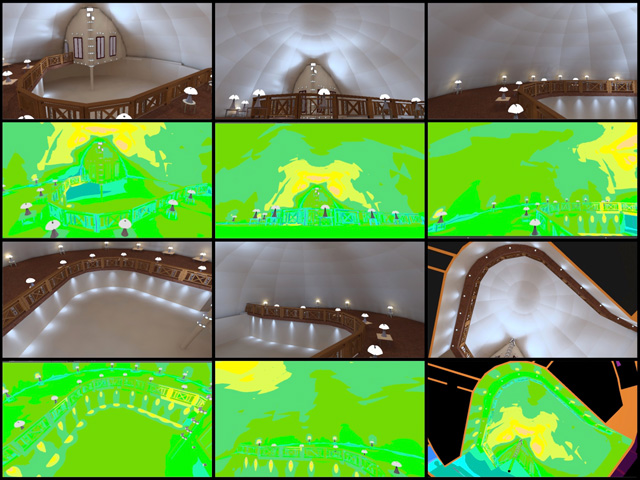
A Blueprint for Transforming the Planet – Continued Lighting Specifics for City Center ” Click for Page
Vamsi Pulugurtha (Mechanical Engineer) also continued work on the thermal lag research and reports for the City Center Heating and Cooling open source hub. What you see here is some of last week’s work and how it ties into the most recent calculations for heat loss and retention by the basement and into the surrounding soil.
HIGHEST GOOD FOOD PROGRESS
 One Community is building a blueprint for transforming the planet through Highest Good food that is more diverse, more nutritious, locally grown and sustainable, and part of our open source botanical garden model to support and share bio-diversity:
One Community is building a blueprint for transforming the planet through Highest Good food that is more diverse, more nutritious, locally grown and sustainable, and part of our open source botanical garden model to support and share bio-diversity:
- Learn about the structures: Hoop House Hub | Aquapini & Walipini Open Source Hub
- See what we’ll be growing: Gardens & Hoop Houses | Large-scale Structures | Food Forest | TA
This week, the core team continued editing the food pages. We added to the “Suggested Initial Dry Pantry” section of the Food Procurement and Storage Plan and the “Bulk Dried Goods” section of the Food Self-sufficiency Transition Plan pages, as you see here.
The core team also updated the Transition Kitchen with new cost analysis details, additional hexayurt resources, and better formatting and menus.

A Blueprint for Transforming the Planet – Transition Kitchen with New Cost Analysis – Click for Page
HIGHEST GOOD EDUCATION PROGRESS
 One Community is building a blueprint for transforming the planet through Highest Good education that is for all ages, applicable in any environment, adaptable to individual needs, far exceeds traditional education standards, and more fun for both the teachers and the students:
One Community is building a blueprint for transforming the planet through Highest Good education that is for all ages, applicable in any environment, adaptable to individual needs, far exceeds traditional education standards, and more fun for both the teachers and the students:
- Learn about the components: Education open source hub
- Learn how the components work together: How to use the Education for Life Program
This week, the core team continued the process of a final proofreading and editing of all 52 lesson plans. This week we completed the Reality Lesson Plan and the Fulfilled Living Lesson Plan. This brings us to 50 of 52 finished, which is 96.2% completion.
Working with Sangam Stanczak (Ph.D. and P.E.), we also finished behind-the-scenes development of the documentation for the Evaluation and Evolution component and finished 4 rounds to testing the use of the documents. You can see some of this work here.

A Blueprint for Transforming the Planet -Documentation for Evaluation and Evolution – Click to Visit
HIGHEST GOOD SOCIETY PROGRESS
 One Community is building a blueprint for transforming the planet through a Highest Good society approach to living that is founded on fulfilled living, the study of meeting human needs, Community, and making a difference in the world:
One Community is building a blueprint for transforming the planet through a Highest Good society approach to living that is founded on fulfilled living, the study of meeting human needs, Community, and making a difference in the world:
- Read the Highest Good society overview: Highest Good Society
- Learn about the model for fulfilled living and sharing: A Day in the Life
- Learn about the 4 economic models: RBE | For-profit | Non-profit | Entrepreneurship
- Learn about our open source community collaboration and management software: The Highest Good Network
This week the core team invested several more hours developing the graphic showing where all our collaborators and volunteers are from. The focus was continuing to add and organize people into their respective locations in the master layer for the video map. This information will be featured in our overview video and on the Team page. You can see here this work in progress.
Ashwin Patil (Web Developer) began creation of the Highest Good society search engine version 2.0, integrating suggested edits and missing pages. You can see some of this work-in-progress here and we’d say this search engine is now 50% complete.

A Blueprint for Transforming the Planet – The Highest Good Society Search Engine – Click to Visit Page
In addition to this, Neha Verma (Software Development Manager) finished her 3rd week helping with the development of the Highest Good Network software. This week’s focus was learning the basics of Ember.js through online tutorials, as shown here.
AND WE PRODUCED THIS WEEKLY UPDATES BLOG – CLICK HERE TO SUBSCRIBE
FOLLOW ONE COMMUNITY’S PROGRESS (click icons for our pages)
INVESTOR PAGES
GET INVOLVED
CONSULTANTS | WAYS ANYONE CAN HELP | MEMBERSHIP
CLICK HERE FOR ALL PAST UPDATES
WHAT ONE COMMUNITY IS CREATING
One Community is creating a place to grow together and change the world together thereby Creating a Better World.We are creating a space that helps each other live in integrity with each other and the planet as we strive to be the greatest versions of ourselves. We do this by harmoniously respecting each other, nature, and the rest of our one shared planet.
Our goal is to demonstrate what we feel is the most sustainable, healthy, and fun environment we can create. A place based on compassion, kindness, and collaboration. This replicable community will serve as an example for what is possible.
Throughout our design process we are open sourcing and free-sharing everything needed for construction and replication. This includes what we call “Highest Good” approaches to food, energy, housing, education, for-profit and non-profit economics design, social architecture, fulfilled living, stewardship practices and more. We are creating these resources for implementation as individual components or complete developments called teacher/demonstration hubs. These hubs will help launch additional hubs as awareness and knowledge grow.
BUILDING THE FIRST OF MANY
One Community will be the first teacher/demonstration hub. It will function as an experiential-learning model that facilitates mass participation to address humanity’s most pressing challenges through: A replicable model for expansion, building seven self-sufficient village/city prototypes, becoming the world leader in open-source sustainability solutions, and evolving and expanding ALL aspects of sustainable living.
WHY ONE COMMUNITY IS CREATING THIS
The One Community self-replicating model is capable of creating a sustainable planet within 30 years. We will achieve this by establishing successful teacher/demonstration hubs on every continent. Villages include designs appropriate for each of the five main types of climates. They also include options for even the most challenged economies. These hubs will collaborate with one another, share ideas, resources, and work together as a network to heal the planet. They will also transform the global lifestyle to a more enjoyable, fulfilling, healthy, and sustainable one.
The specifics of how One Community is accomplishing this can be found on the One Community Solution Model to Create Solution-creating Models Page. Research supporting and showing the benefits of a model like this can be found on our Research and Resources Articles Archive.
Even if we don’t achieve our ultimate goal of global transformation, a self-replicating teacher/demonstration model like this will take a relatively short period of time to positively affect millions while inspiring millions more. For One Community residents (the Pioneer Team), the idea of creating and sharing the social and recreational experience with visitors is also fun, exciting, fulfilling, and an additional reason why we are creating this.
SUMMARY
One Community sees the issues of the world as interdependent and interconnected. To address them simultaneously, we are open-source blueprinting a more advanced standard of living by designing holistic, environmentally-regenerative, self-sustaining, adaptable solutions for all areas of sustainability and Creating a Better World . We will model these within a comprehensive “village/city” which will be built in the southwestern U.S. This teacher/demonstration hub will be a place people can experience a new way of living and then replicate it with our open source blueprints: creating a model solution that creates additional solution-creating models.
One Community Welcomes Vivian Rodrigues to the Translation Team
Posted on August 31, 2017 by One Community
One Community welcomes Vivian Rodrigues to the Translation Team as our newest Volunteer/Consultant!

Translator: With a special passion for words, Vivian has spent years doing translations. She began translating even as a child, translating to help people access and understand materials previously inaccessible for them. For years she has continued applying her passion, translating (for free) written and video contents, both recreational and educational. A student of education and self-taught in many other areas, Vivian also enjoys game design and gamification, entrepreneurship, psychology, and music. When she saw her friends becoming unhappy and sick for avoidable reasons, she became motivated to work towards creating a better world. Now, as a One Community Consultant, she is helping to translate key pages of the website (Open Source, Highest Good, Solutions that Create Solutions, etc.) into Portuguese.
WELCOME TO THE TEAM VIVIAN!
FOLLOW ONE COMMUNITY’S PROGRESS (click icons for our pages)
INVESTOR PAGES
GET INVOLVED
One Community Welcomes Dijimba “Joss” Kabuyi Ilunga to the Electrical Engineering Team
Posted on August 27, 2017 by One Community
One Community welcomes Dijimba “Joss” Kabuyi Ilunga to the Electrical Engineering Team as our newest Volunteer/Consultant!

Electrical Engineer: Dijimba earned a Bachelor of Science in Electrical and Electronics Engineering from the University of Texas at Arlington. By his secondary school graduation in the Democratic Republic of Congo, he had a strong affinity for science subjects and decided to pursue an engineering degree in Arlington because of his uncle, a UT Arlington mechanical engineer alumni. During the end of his undergraduate degree, Dijimba became passionate with microelectromechanical systems and power, especially and specifically renewable energy. He has taken graduate classes in both subjects and will pursue his Masters with emphasis on those subjects. He is bilingual in French and English, and he is currently learning Chinese (Mandarin). For recreation, Joss likes video games and is very fond of Sudoku. As a member of the One Community team, Joss completed the Vermiculture Bathroom electrical designs.
WELCOME TO THE TEAM DIJIMBA!
FOLLOW ONE COMMUNITY’S PROGRESS (click icons for our pages)
INVESTOR PAGES
GET INVOLVED
One Community Welcomes Sowmya Manohar to the Software Development Team
Posted on August 27, 2017 by One Community
One Community welcomes Sowmya Manohar to the Software Development Team as our newest Volunteer/Consultant!

Software Engineer, Web Developer & Net Application Developer: Sowmya received her Bachelor’s in Electrical and Electronics Engineering with distinction (Gold Medalist) from one of India’s reputed universities, Pondicherry University. Due to her passion in programming, she pursued her career as a programmer and application developer. She is also a Microsoft Certified Technology specialist. In her spare time, Sowmya enjoys painting, creating with beads, and solving sudoku puzzles. She strongly believes that change starts from within and, as a member of the One Community Team, is helping develop the Highest Good Network Software.
WELCOME TO THE TEAM SOWMYA!
FOLLOW ONE COMMUNITY’S PROGRESS (click icons for our pages)
INVESTOR PAGES
GET INVOLVED
Creating Something Good for Everyone – One Community Weekly Progress Update #231
Posted on August 27, 2017 by One Community
Open source sustainability means creating something good for everyone. Expanding open sourcing and free-sharing sustainability beyond food, energy, and housing to also include education, for-profit and non-profit economic design, social architecture, fulfilled living, and global stewardship practices is even better. One Community is an all-volunteer nonprofit developing all of these in support of a global collaboration for The Highest Good of all people and life on our planet.
- Here’s our project overview
- Here’s our world-change methodology
- Here’s how this becomes self-replicating
- Here’s how we are open source and free-sharing all the do-it-yourself designs

OUR MAIN OPEN SOURCE HUBS
Click on each icon to be taken to the corresponding Highest Good hub page.
One Community’s physical location will forward this movement as the first of many self-replicating teacher/demonstration communities, villages, and cities to be built around the world. This is the August 27th, 2017 edition (#231) of our weekly progress update detailing our team’s development and accomplishments:
Creating Something Good for Everyone
One Community Progress Update #231
Here is the bullet-point list of this last week’s design and progress discussed in detail in the video above:
CREATING SOMETHING GOOD FOR EVERYONE INTRO: @0:34
HIGHEST GOOD HOUSING: @5:36
- Continued updating the images and formatting for the Earthbag Village Communal Eco-shower page (see below)
- Updated the complete thermostatic mixing valve page (see below)
- Continued working in Sketchup on the open source outdoor areas of the Recycled Materials Village (see below)
- Continued development of the Tree House Village renders (see below)
- Hemanth Kotaru completed his 4th week with us by conducting additional Earthbag Village construction research (see below)
- Christian Ojeda completed his 24th week helping with the plumbing details for the heat-recycling Communal Eco-shower, Vermiculture Bathroom, and Net-zero Communal Bathroom Designs (see below)
- Dean Scholz continued helping us create quality Cob Village renders (see below)
- Hamilton Mateca finished his 52nd week helping with the Compressed Earth Block Village design and render details (see below)
- Aparna Tandon continued her work on the Compressed Earth Block Village external elements (see below)
- Guy Grossfeld continued helping with the Tree House Village renders (see below)
- Samantha Robinson completed her 4th week working on the interior design for the living structure of the Tree House Village (see below)
DUPLICABLE CITY CENTER: @8:53
- Added the final updated header and social media images to the Pipe Furniture page and shared it for the first time across social media (see below)
- Haoxuan “Hayes” Lei continued work on the City Center structural engineering tutorial (see below)
- Dipti Dhondarkar continued with her 47th week of work on the lighting specifics for the City Center (see below)
- Aravind Vasudevan and Vamsi Pulugurtha continued work on their thermal lag and climate battery research and reports for the City Center Heating and Cooling open source hub (see below)
HIGHEST GOOD FOOD: @10:10
- Created images for the Food Procurement and Storage Plan and Food Self-sufficiency Transition Plan pages (see below)
HIGHEST GOOD EDUCATION: @10:40
- Continued the process of a final proofreading and editing of all 52 lesson plans (see below)
- Completed the draft of the Orff page, and reviewed and reedited the Reggio, Waldorf behind-the-scenes content and began work on the additional Multi-intelligences research and content (see below)
HIGHEST GOOD SOCIETY: @11:28
- Invested several more hours developing the graphic showing where all our collaborators and volunteers are from. This information will be featured in our overview video and on the Team page (see below)
- Sowmya Manohar, working on the Highest Good Network software, finished coding in Express.js for retrieving data from MongoDB based on a specific id (see below)
- Priti Kothari completed her 2nd week helping with the Highest Good Network software by finishing version 1.0 of the Leaderboard element (see below)
- Neha Verma finished her 2nd week helping with the Highest Good Network software by finishing implementation of the time log widget (see below)
CREATING SOMETHING GOOD FOR EVERYONE SUMMARY: @12:46
- How you can most help us right now and how anyone can help
CLICK HERE IF YOU’D LIKE TO RECEIVE AN EMAIL EACH WEEK WHEN WE RELEASE A NEW UPDATE
YOU CAN ALSO JOIN US THROUGH SOCIAL MEDIA
ONE COMMUNITY WEEKLY UPDATE DETAILS
HIGHEST GOOD HOUSING PROGRESS
 One Community is creating something good for everyone through Highest Good housing that is artistic and beautiful, more affordable, more space efficient, lasts longer, DIY buildable, and constructed with healthy and sustainable materials:
One Community is creating something good for everyone through Highest Good housing that is artistic and beautiful, more affordable, more space efficient, lasts longer, DIY buildable, and constructed with healthy and sustainable materials:
- Learn about: Our Upcoming Crowdfunding Campaign
- Learn about the different village models: 7 Sustainable Village Models
- Visit the open source portals for the first two: Earthbag Village OS Hub | Straw Bale Village OS Hub
This week the core team continued updating the images and formatting for the Earthbag Village Communal Eco-shower page, separating out the different designs and adding several new sections. You can see some of this work here.
Related to this, we also updated the complete thermostatic mixing valve page. You can see some of the updated page here.
The core team additionally continued Sketchup design for the open source outdoor areas of the Recycled Materials Village (Pod 6). We designed a cable spool table with seats, and finished designing the bench with roof and bookshelves. The team also began designing a table with a bench made from tires. The top-right picture inspired the idea.
In addition to this, the core team continued development of the two Tree House Village (Pod 7) renders shown here, updating trees, adding people, and other aesthetic elements.
Hemanth Kotaru (Structural Engineering Masters Student) completed his 4th week with us by conducting additional Earthbag Village construction research. This week’s focus was more french drain and water proofing research and you can see a summary of the findings so far here.
And Christian Ojeda(Mechatronic Engineer) completed his 24th week helping with the plumbing details for the heat-recycling Communal Eco-shower, Vermiculture Bathroom, and Net-zero Communal Bathroom Designs. This week’s work on the plumbing was focused on the water heater details, integration of the rainwater collection system, and other minor changes. This brings us to 90% complete with the plumbing for the whole Earthbag Village.
Dean Scholz (Architectural Designer) continued helping us create quality Cob Village (Pod 3) renders. Here is update 81 of Dean’s work, continuing to test and develop the lighting from the skylights and windows for the central dining and presentation hall.

Creating Something Good for Everyone – Continued Help – Quality Cob Village Renders – Click for Page
Hamilton Mateca (AutoCAD and Revit Drafter and Designer) also finished his 52nd week helping with the Compressed Earth Block Village design and render details. This week’s focus was finishing this final high-quality render for the East-wing office spaces, which you can see here and is now also added to the website.
Aparna Tandon (Architect) continued her work on the Compressed Earth Block Village external elements. What you see here is her 31st week of work, focusing on 3D Sketchup development of the central area between the North and South residential wings, plus zones 12 and 14 by the East offices.
Guy Grossfeld (Graphic Designer) continued helping with the Tree House Village (Pod 7) renders. This week he made final changes and ran the final master render for the village, which you can see here.
Samantha Robinson (3D Designer) completed her 4th week working on the interior design for the living structure of the Tree House Village (Pod 7). This week’s focus, as shown here, was mostly work on the staircase, 2nd floor door, and light design.
DUPLICABLE CITY CENTER PROGRESS
 One Community is creating something good for everyone through a Duplicable and Sustainable City Center that is LEED Platinum certified/Sustainable, can feed 200 people at a time, provide laundry for over 300 people, is beautiful, spacious, and saves resources, money, and space:
One Community is creating something good for everyone through a Duplicable and Sustainable City Center that is LEED Platinum certified/Sustainable, can feed 200 people at a time, provide laundry for over 300 people, is beautiful, spacious, and saves resources, money, and space:
- Learn about this building and it’s function: Duplicable City Center Open Source Hub
This week, the core team added the final updated header and social media images to the Pipe Furniture page and shared it for the first time across social media.

Creating Something Good for Everyone – Header, Social Media Images to Pipe Furniture – Click to Visit
Haoxuan “Hayes” Lei (Structural Engineer) continued work on the City Center structural engineering tutorial. What you see here is his 4th week of writing content. This week’s content focus was exposure and topographic considerations.
Dipti Dhondarkar, (Electrical Engineer) continued with her 47th week of work on the lighting specifics for the City Center. This week’s focus was adding the loft-overhang accent lights and updating the table lamps and bulbs to better match those we’ll be actually using.
Aravind Vasudevan: (Mechanical Engineer) and Vamsi Pulugurtha (Mechanical Engineer) also continued work on their thermal lag and climate battery research and reports for the City Center Heating and Cooling open source hub. What you see here are pictures from our weekly collaborative call and some of their work on the fan and heat transfer calculations.
HIGHEST GOOD FOOD PROGRESS
 One Community is creating something good for everyone through Highest Good food that is more diverse, more nutritious, locally grown and sustainable, and part of our open source botanical garden model to support and share bio-diversity:
One Community is creating something good for everyone through Highest Good food that is more diverse, more nutritious, locally grown and sustainable, and part of our open source botanical garden model to support and share bio-diversity:
- Learn about the structures: Hoop House Hub | Aquapini & Walipini Open Source Hub
- See what we’ll be growing: Gardens & Hoop Houses | Large-scale Structures | Food Forest | TA
This last week the core team continued editing the food pages. We created these images for the Food Procurement and Storage Plan and Food Self-sufficiency Transition Plan pages, as you see here.
HIGHEST GOOD EDUCATION PROGRESS
 One Community is creating something good for everyone through Highest Good education that is for all ages, applicable in any environment, adaptable to individual needs, far exceeds traditional education standards, and more fun for both the teachers and the students:
One Community is creating something good for everyone through Highest Good education that is for all ages, applicable in any environment, adaptable to individual needs, far exceeds traditional education standards, and more fun for both the teachers and the students:
- Learn about the components: Education open source hub
- Learn how the components work together: How to use the Education for Life Program
This week, the core team continued the process of a final proofreading and editing of all 52 lesson plans. This week we completed the Diversity Lesson Plan and the Caring and Kindness Lesson Plan. This brings us to 48 of 52 finished, which is 92.3% completion.
The core team also completed the draft of the Orff page, and reviewed and reedited the Reggio, Waldorf behind-the-scenes content and began work on the additional Multi-intelligences research and content.

Creating Something Good for Everyone – Orff, Reggio, Waldorf, Multi-Intellegences Content – Click for Page
HIGHEST GOOD SOCIETY PROGRESS
 One Community is creating something good for everyone through a Highest Good society approach to living that is founded on fulfilled living, the study of meeting human needs, Community, and making a difference in the world:
One Community is creating something good for everyone through a Highest Good society approach to living that is founded on fulfilled living, the study of meeting human needs, Community, and making a difference in the world:
- Read the Highest Good society overview: Highest Good Society
- Learn about the model for fulfilled living and sharing: A Day in the Life
- Learn about the 4 economic models: RBE | For-profit | Non-profit | Entrepreneurship
- Learn about our open source community collaboration and management software: The Highest Good Network
This last week the core team invested several more hours developing the graphic showing where all our collaborators and volunteers are from. The focus was adding and organizing what will be the first wave of images that will appear. This information will be featured in our overview video and on the Team page. You can see here this work in progress.
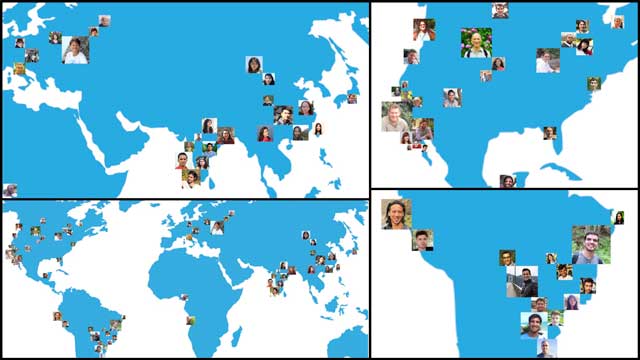
Creating Something Good for Everyone – Graphic of collaborators & volunteers locations – Click for Team
In addition to this, Sowmya Manohar (Software Engineer, Web Developer & Net Application Developer) working on the Highest Good Network software, finished coding in Express.js for retrieving data from MongoDB based on a specific id. Priti Kothari (Information Technology Enthusiast) also completed her 2nd week helping with this part of the project by finishing version 1.0 of the Leaderboard element, and Neha Verma (Software Development Manager) finished her 2nd week helping with this component by finishing implementation of the time log widget. Snapshots of all of this work are shown here.
AND WE PRODUCED THIS WEEKLY UPDATES BLOG – CLICK HERE TO SUBSCRIBE
FOLLOW ONE COMMUNITY’S PROGRESS (click icons for our pages)
INVESTOR PAGES
GET INVOLVED
CONSULTANTS | WAYS ANYONE CAN HELP | MEMBERSHIP
CLICK HERE FOR ALL PAST UPDATES
WHAT ONE COMMUNITY IS CREATING
One Community is creating a place to grow together and change the world together thereby Creating a Better World.We are creating a space that helps each other live in integrity with each other and the planet as we strive to be the greatest versions of ourselves. We do this by harmoniously respecting each other, nature, and the rest of our one shared planet.
Our goal is to demonstrate what we feel is the most sustainable, healthy, and fun environment we can create. A place based on compassion, kindness, and collaboration. This replicable community will serve as an example for what is possible.
Throughout our design process we are open sourcing and free-sharing everything needed for construction and replication. This includes what we call “Highest Good” approaches to food, energy, housing, education, for-profit and non-profit economics design, social architecture, fulfilled living, stewardship practices and more. We are creating these resources for implementation as individual components or complete developments called teacher/demonstration hubs. These hubs will help launch additional hubs as awareness and knowledge grow.
BUILDING THE FIRST OF MANY
One Community will be the first teacher/demonstration hub. It will function as an experiential-learning model that facilitates mass participation to address humanity’s most pressing challenges through: A replicable model for expansion, building seven self-sufficient village/city prototypes, becoming the world leader in open-source sustainability solutions, and evolving and expanding ALL aspects of sustainable living.
WHY ONE COMMUNITY IS CREATING THIS
The One Community self-replicating model is capable of creating a sustainable planet within 30 years. We will achieve this by establishing successful teacher/demonstration hubs on every continent. Villages include designs appropriate for each of the five main types of climates. They also include options for even the most challenged economies. These hubs will collaborate with one another, share ideas, resources, and work together as a network to heal the planet. They will also transform the global lifestyle to a more enjoyable, fulfilling, healthy, and sustainable one.
The specifics of how One Community is accomplishing this can be found on the One Community Solution Model to Create Solution-creating Models Page. Research supporting and showing the benefits of a model like this can be found on our Research and Resources Articles Archive.
Even if we don’t achieve our ultimate goal of global transformation, a self-replicating teacher/demonstration model like this will take a relatively short period of time to positively affect millions while inspiring millions more. For One Community residents (the Pioneer Team), the idea of creating and sharing the social and recreational experience with visitors is also fun, exciting, fulfilling, and an additional reason why we are creating this.
SUMMARY
One Community sees the issues of the world as interdependent and interconnected. To address them simultaneously, we are open-source blueprinting a more advanced standard of living by designing holistic, environmentally-regenerative, self-sustaining, adaptable solutions for all areas of sustainability and Creating a Better World . We will model these within a comprehensive “village/city” which will be built in the southwestern U.S. This teacher/demonstration hub will be a place people can experience a new way of living and then replicate it with our open source blueprints: creating a model solution that creates additional solution-creating models.
 One Community
One Community
